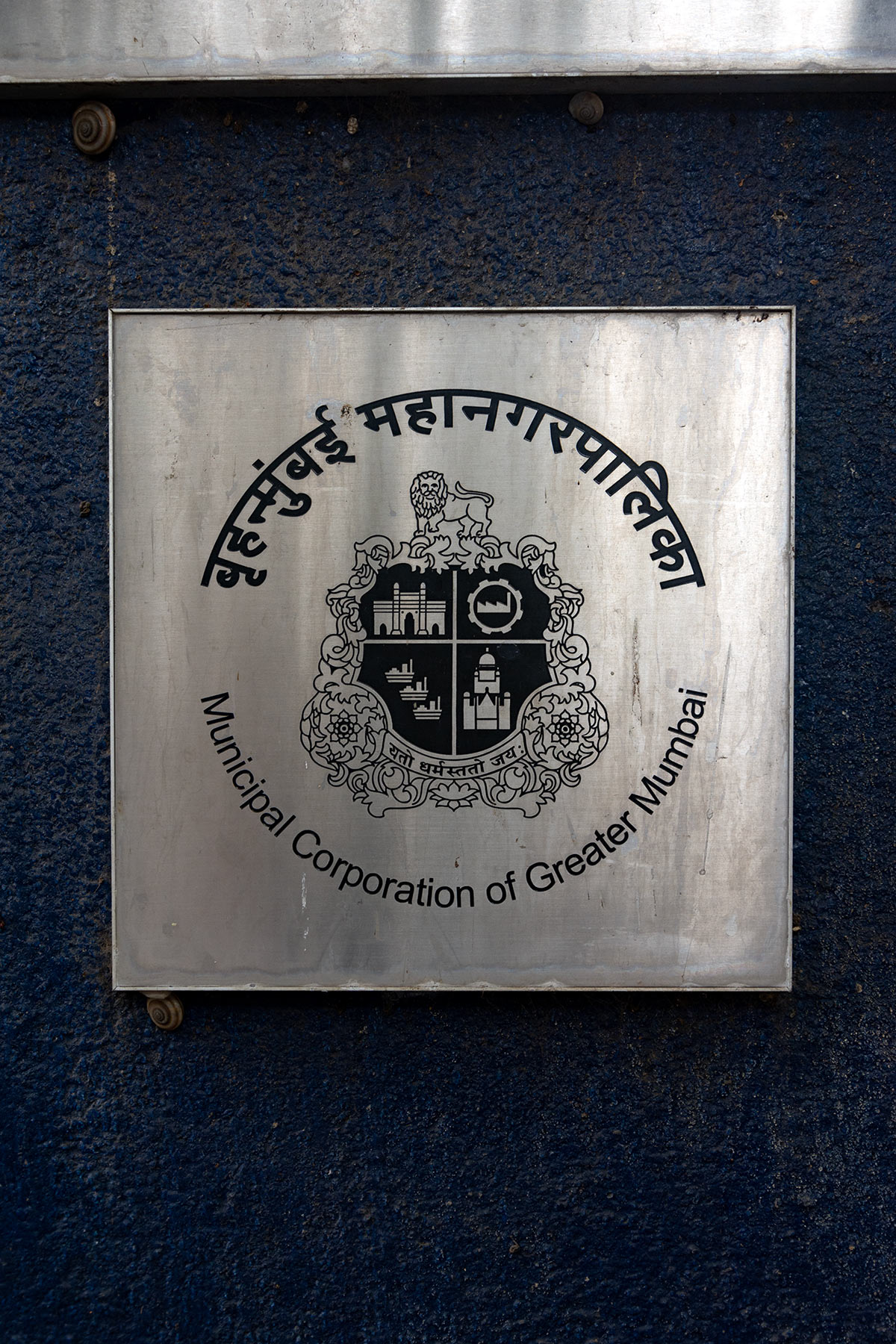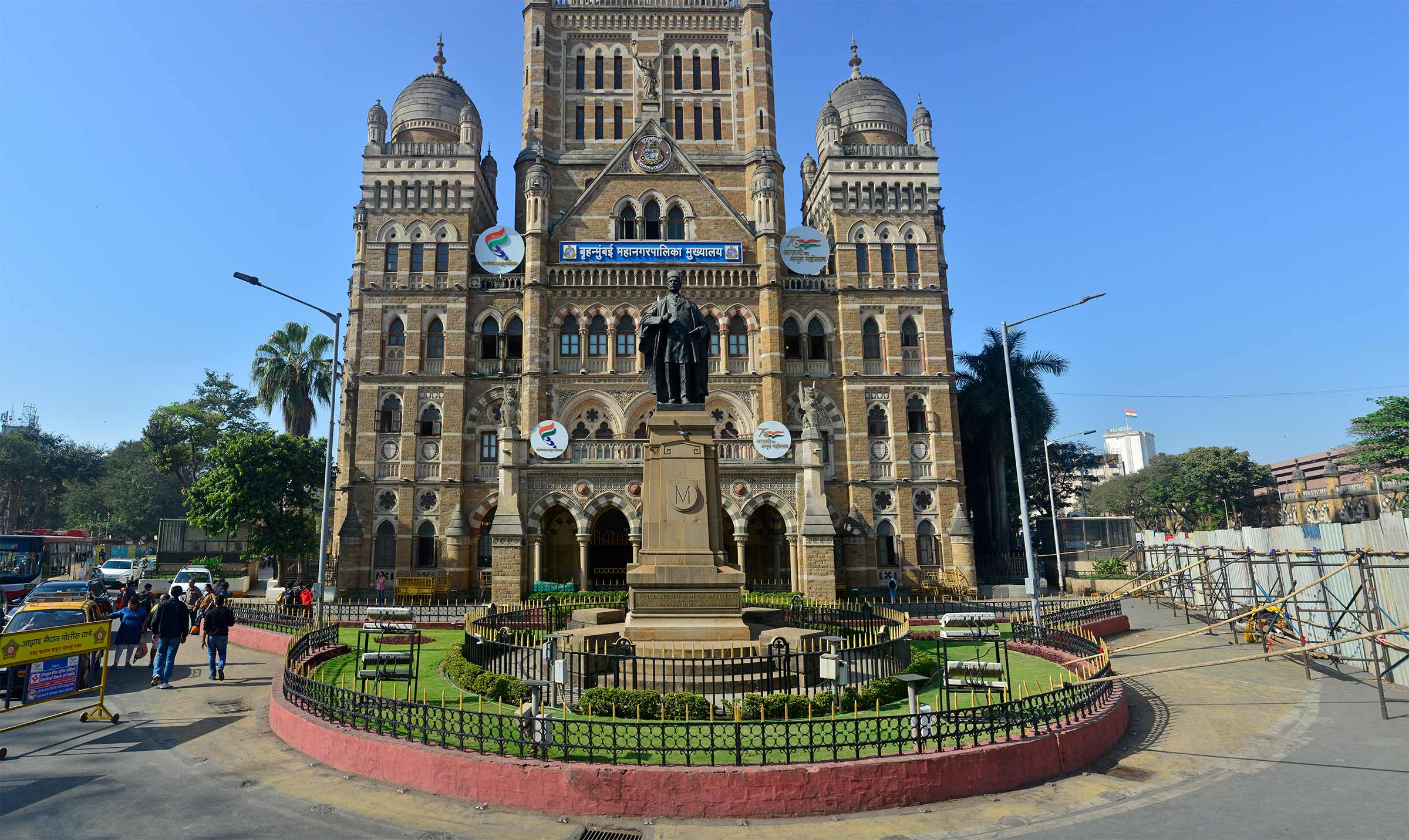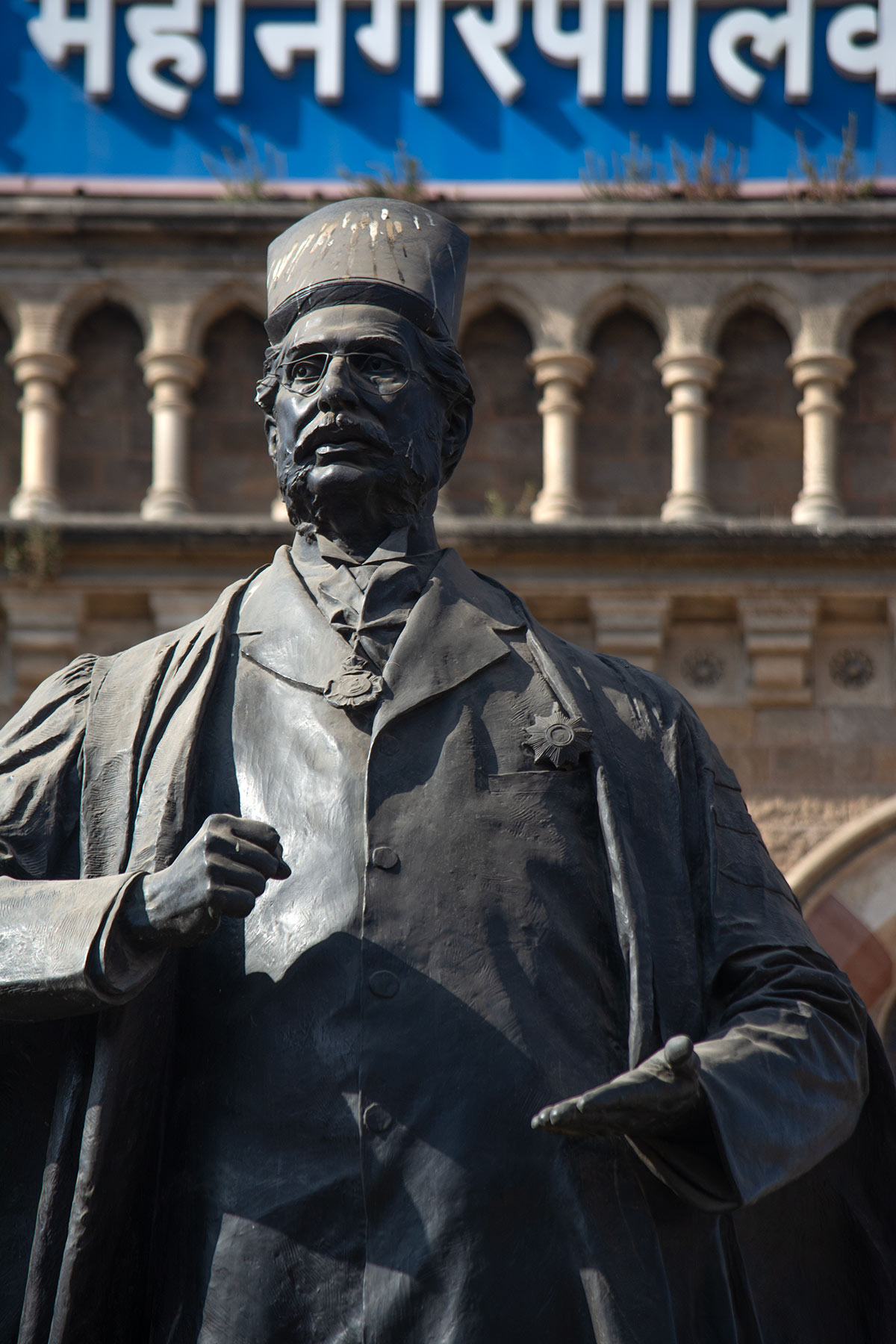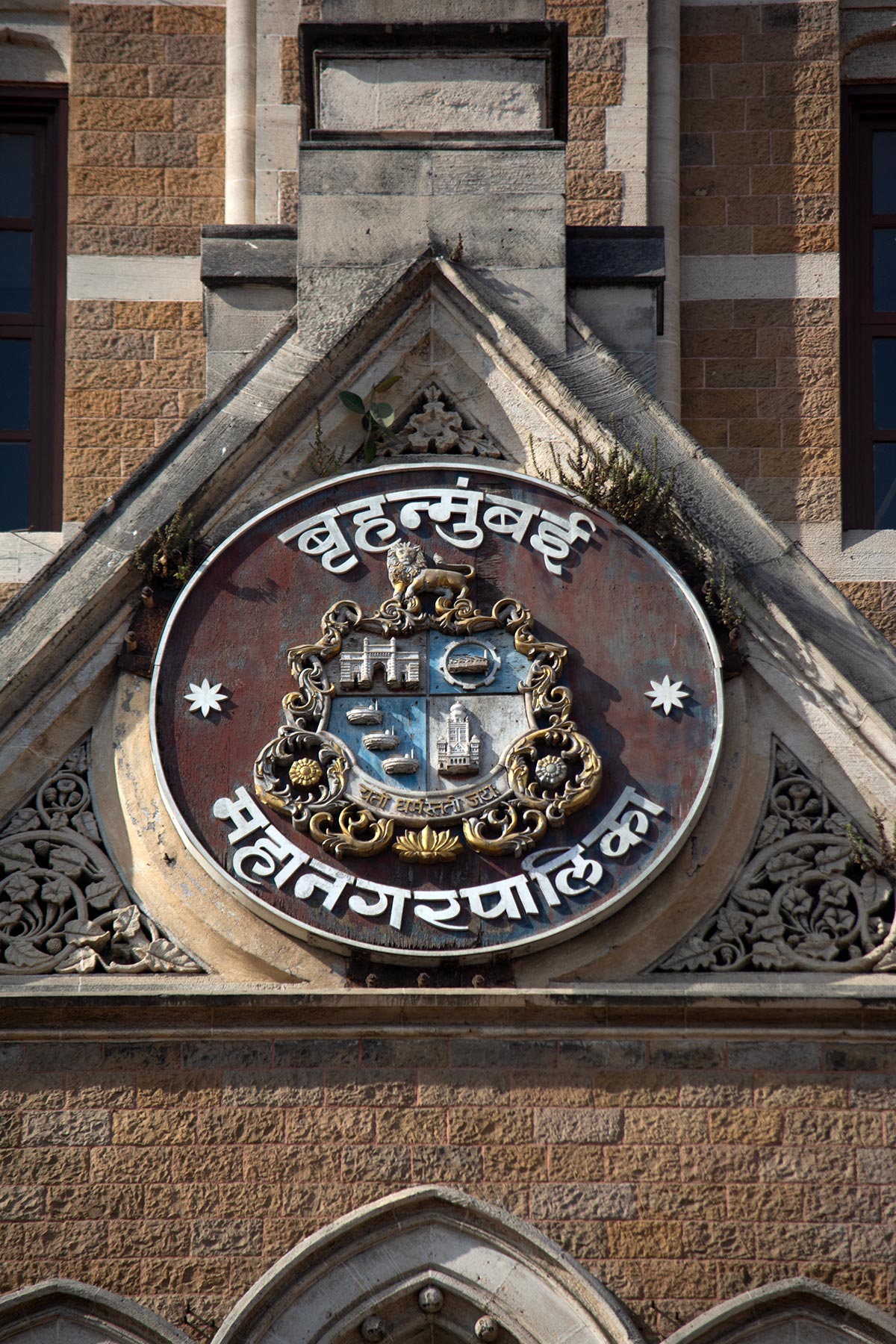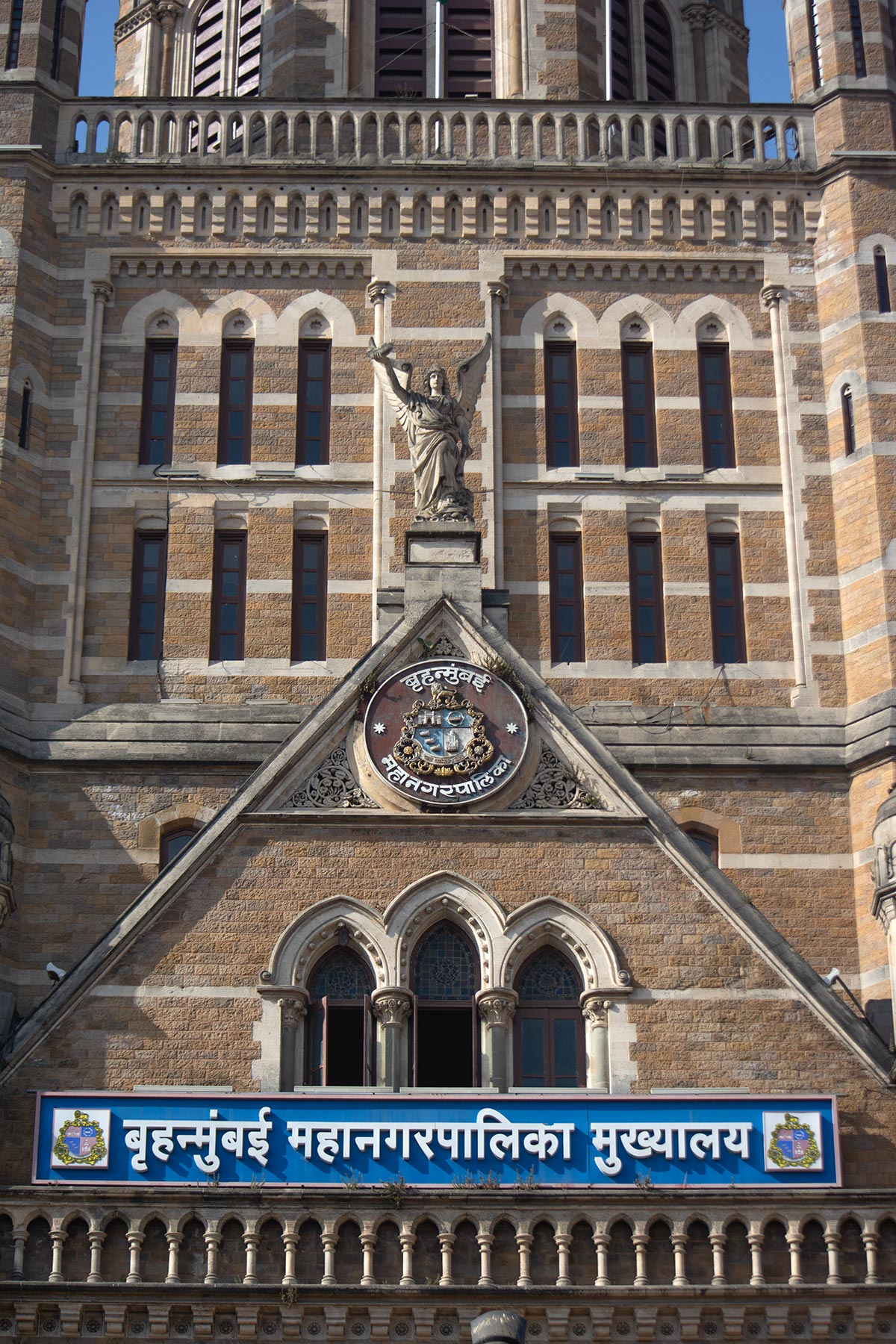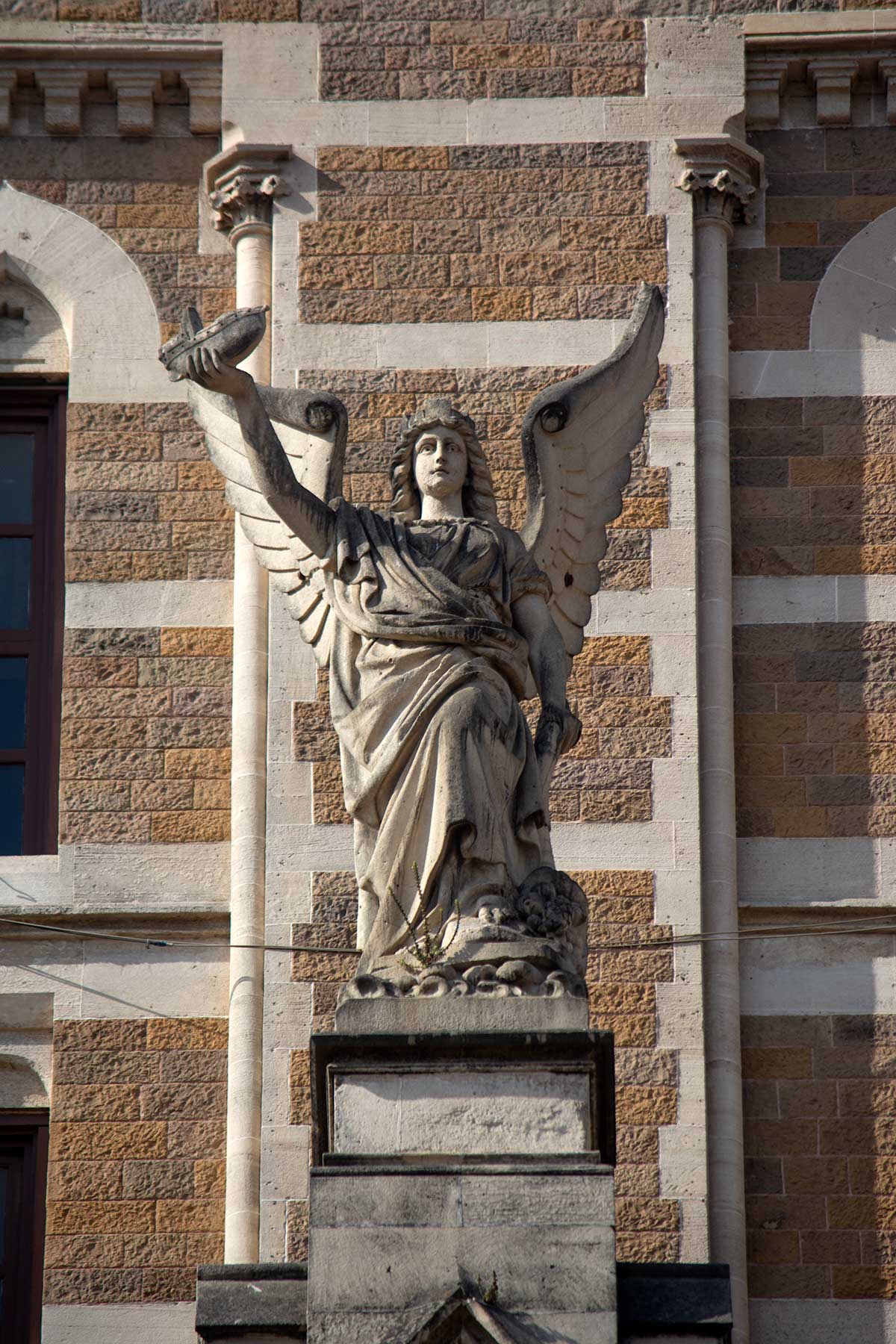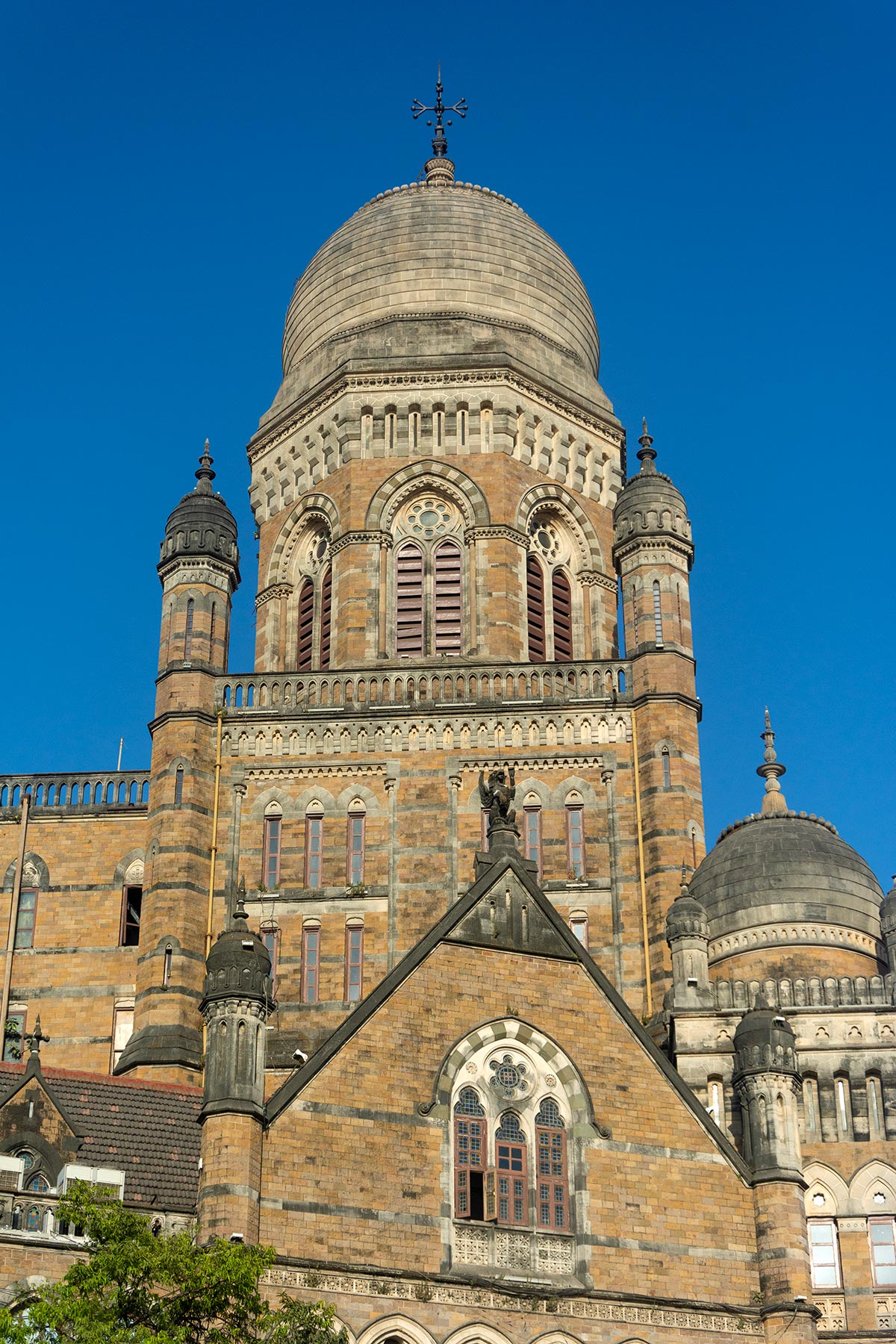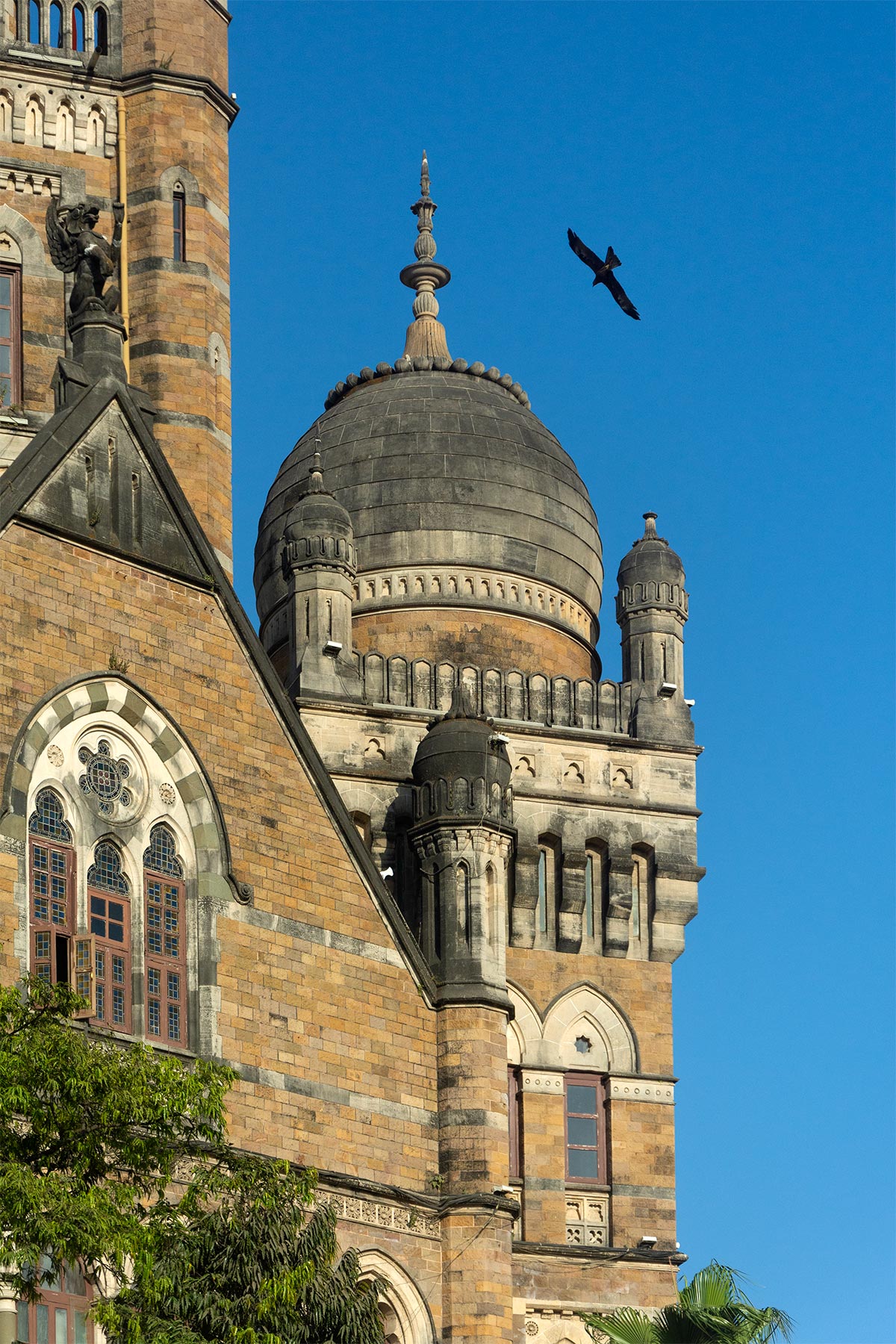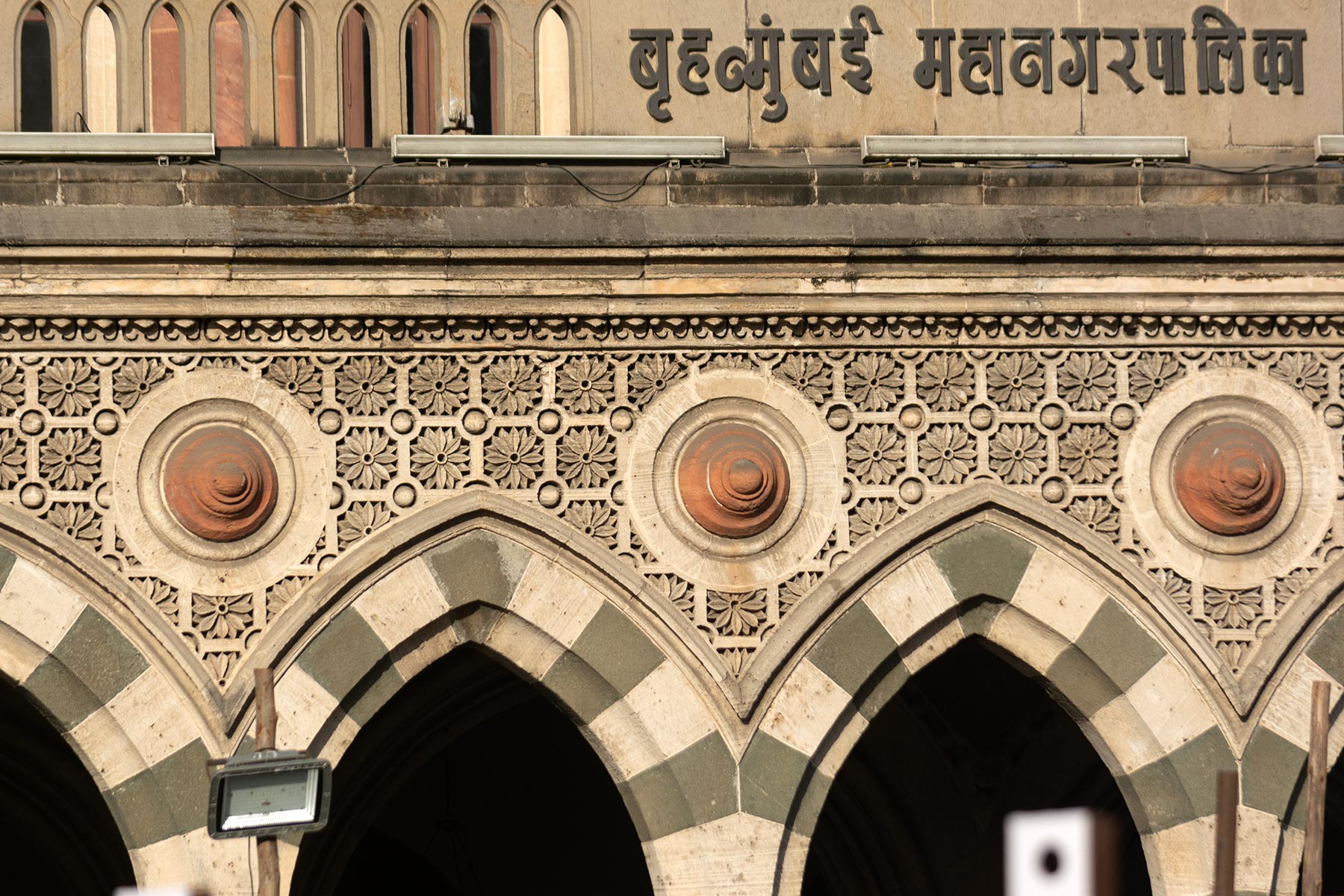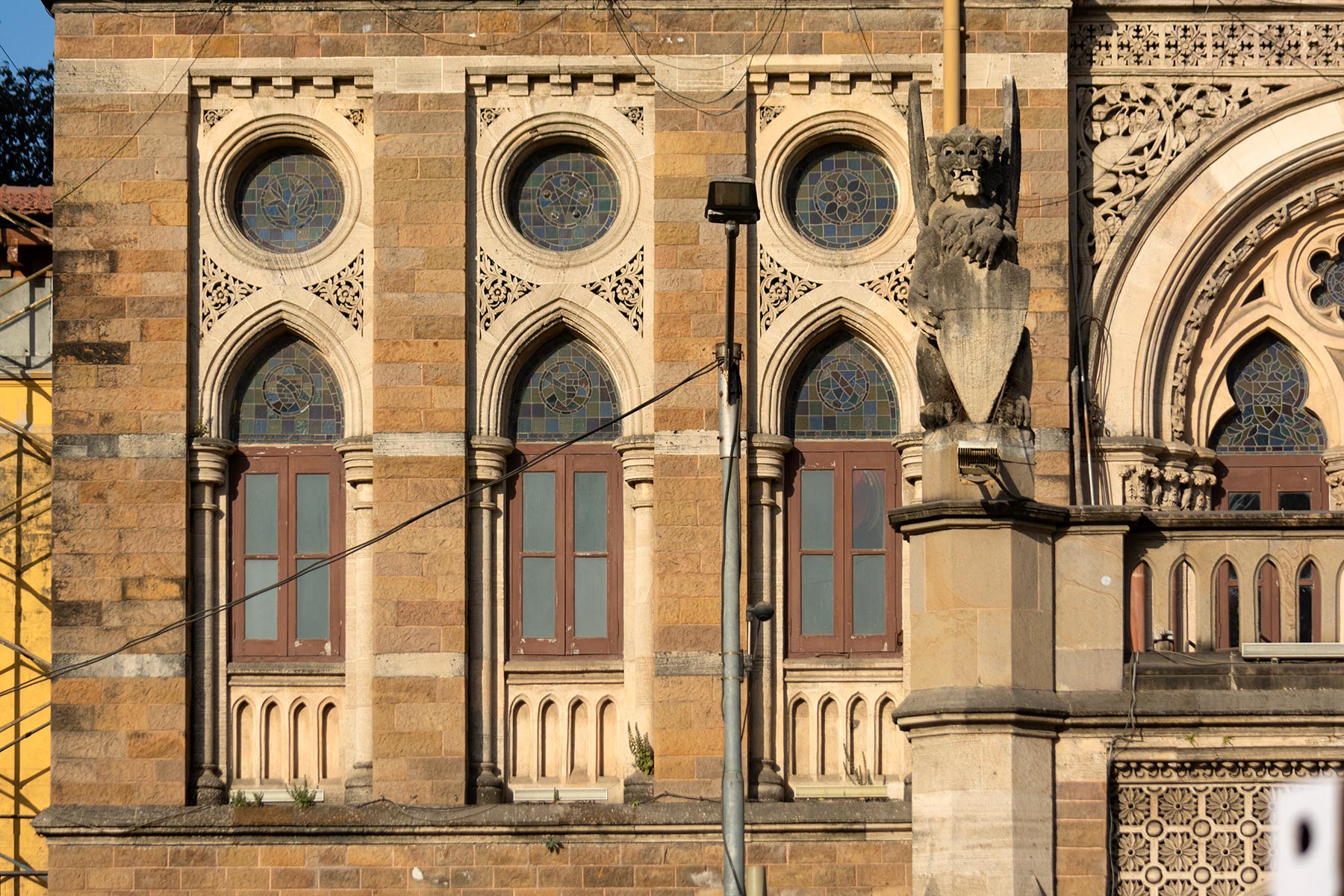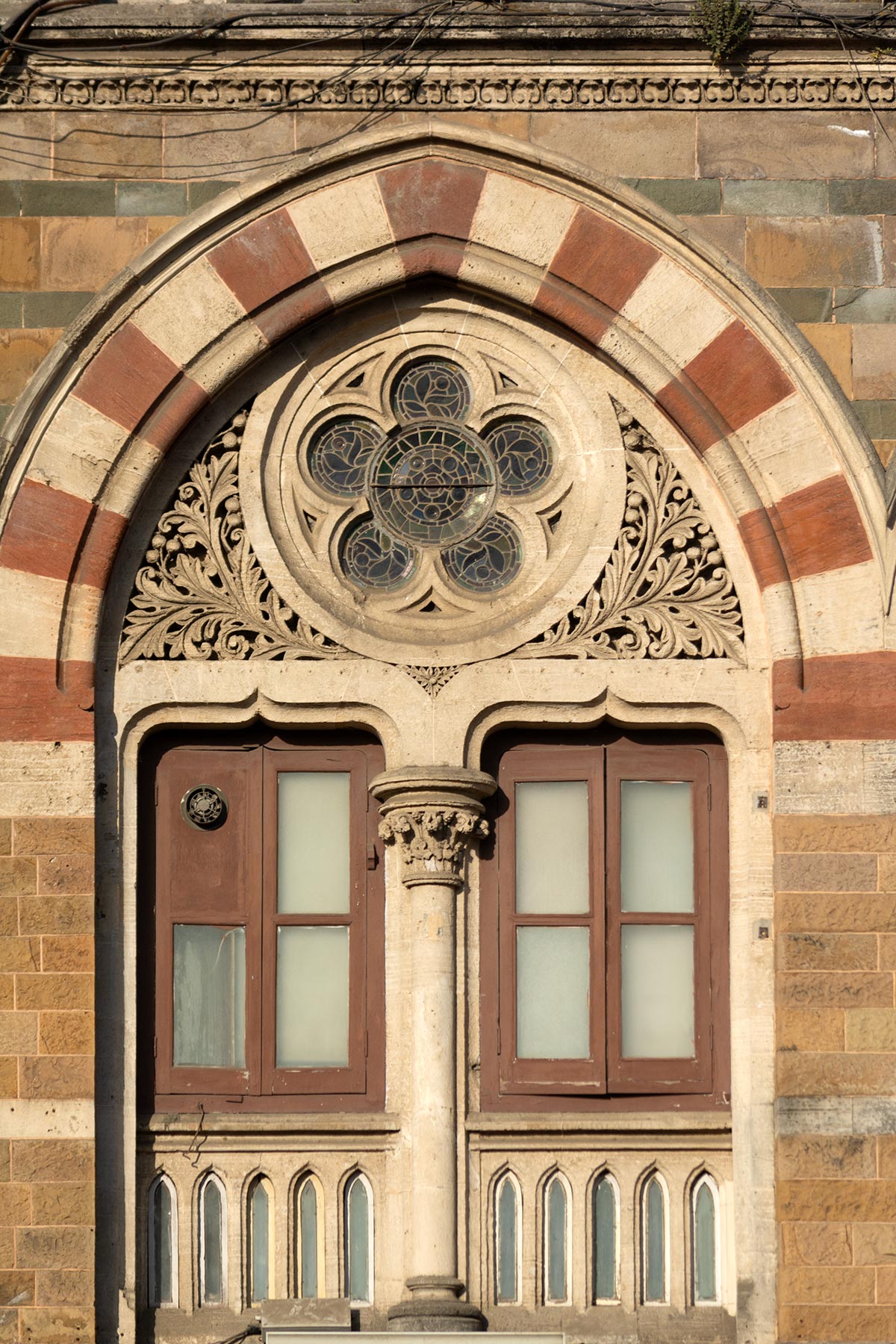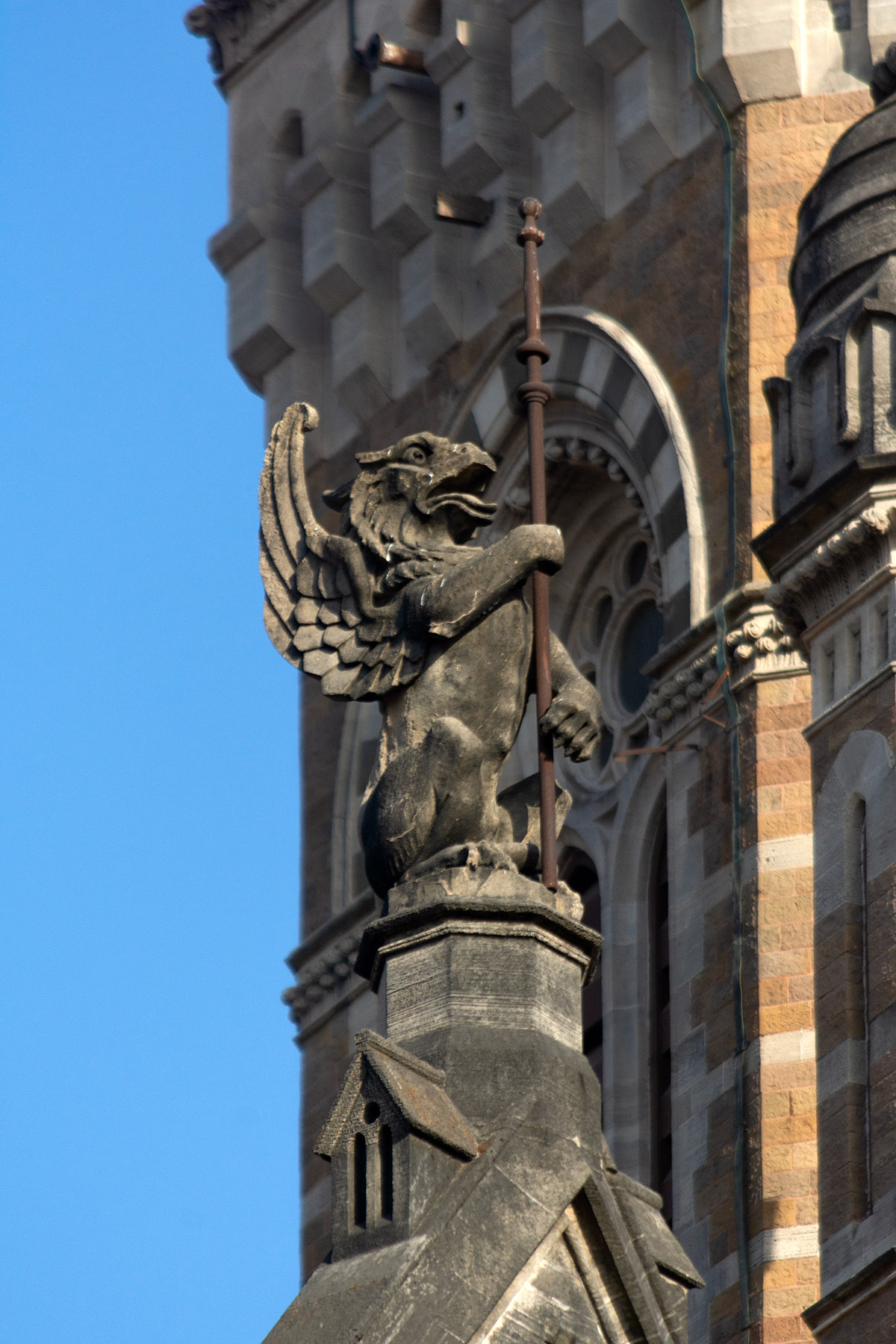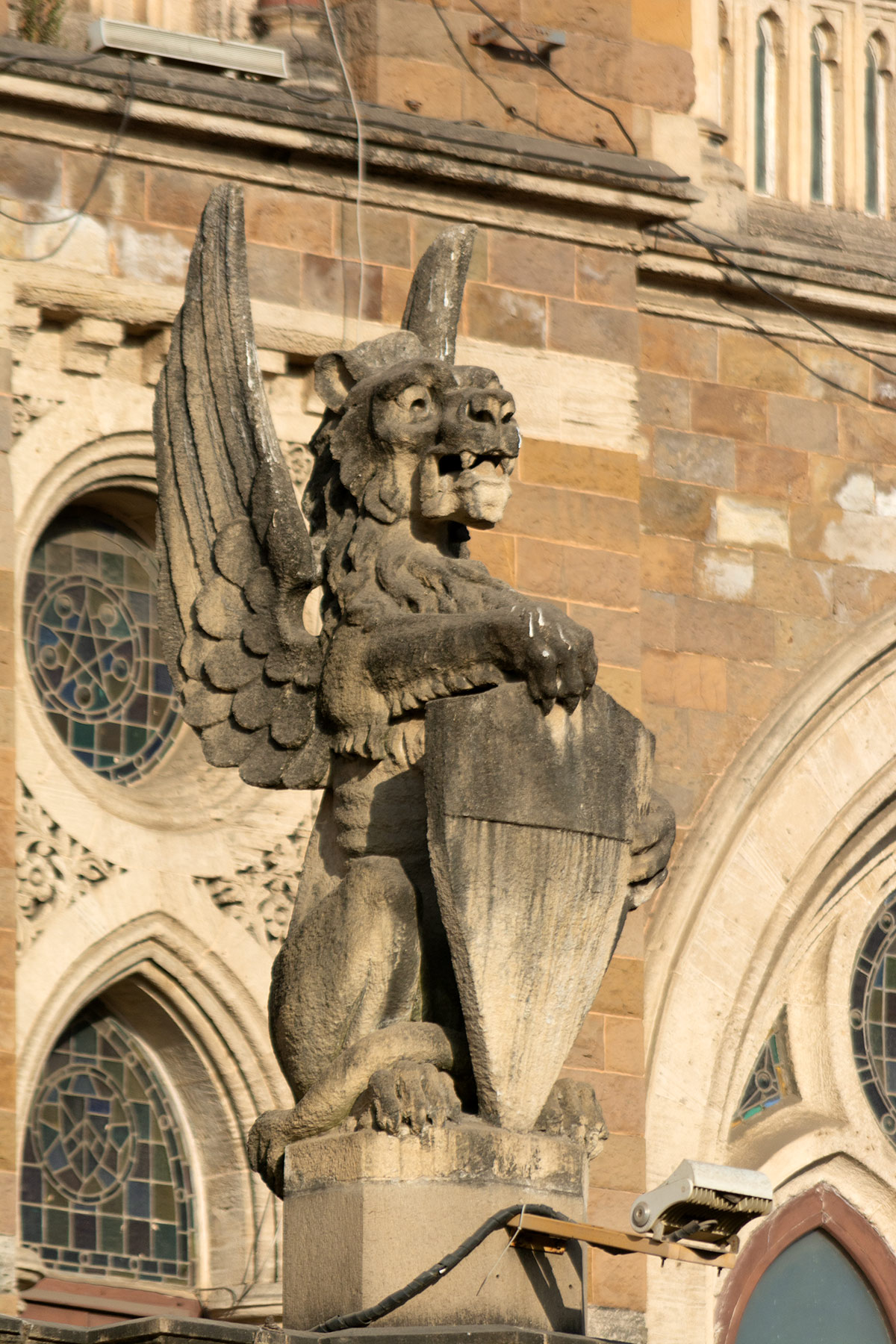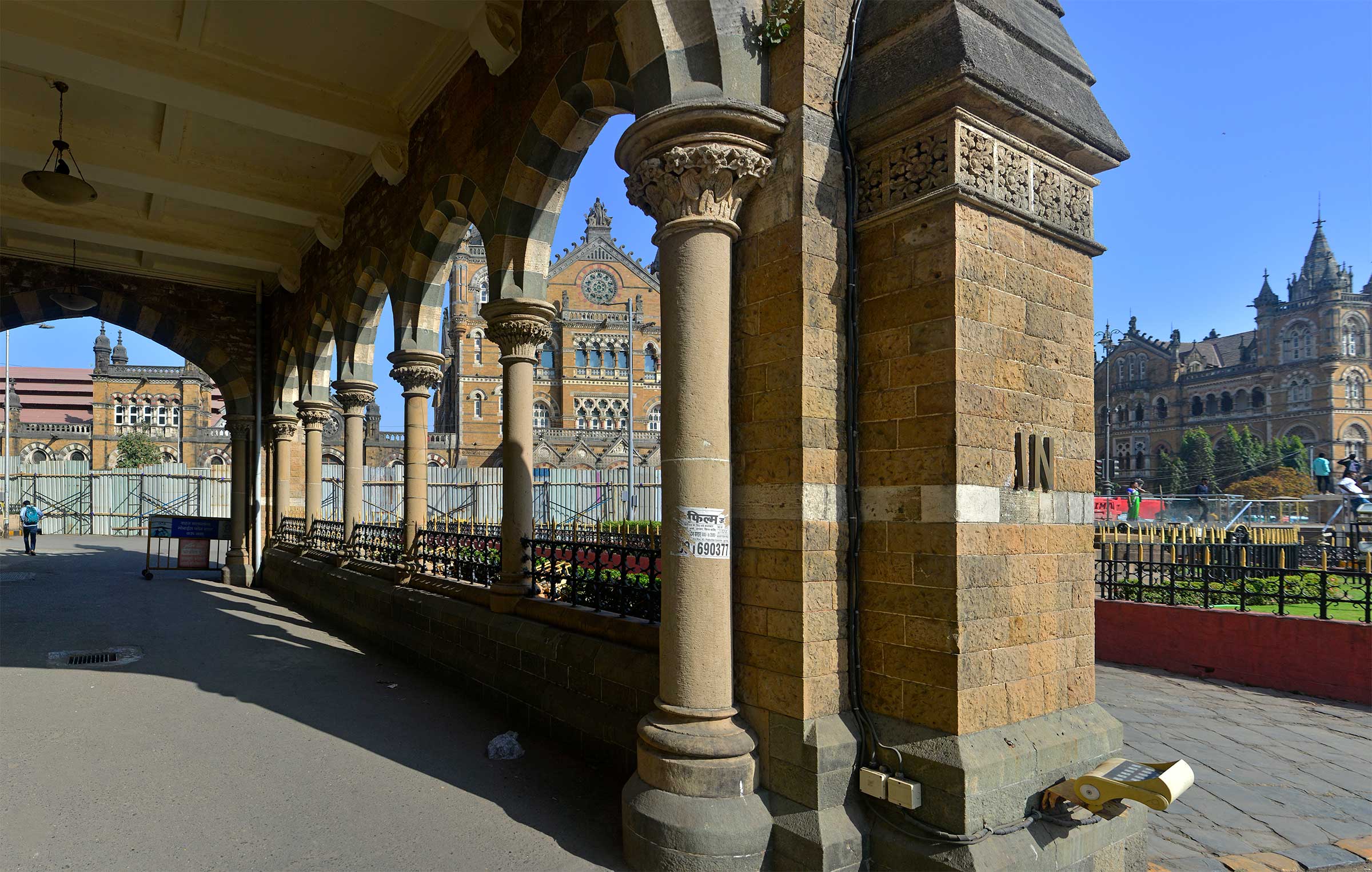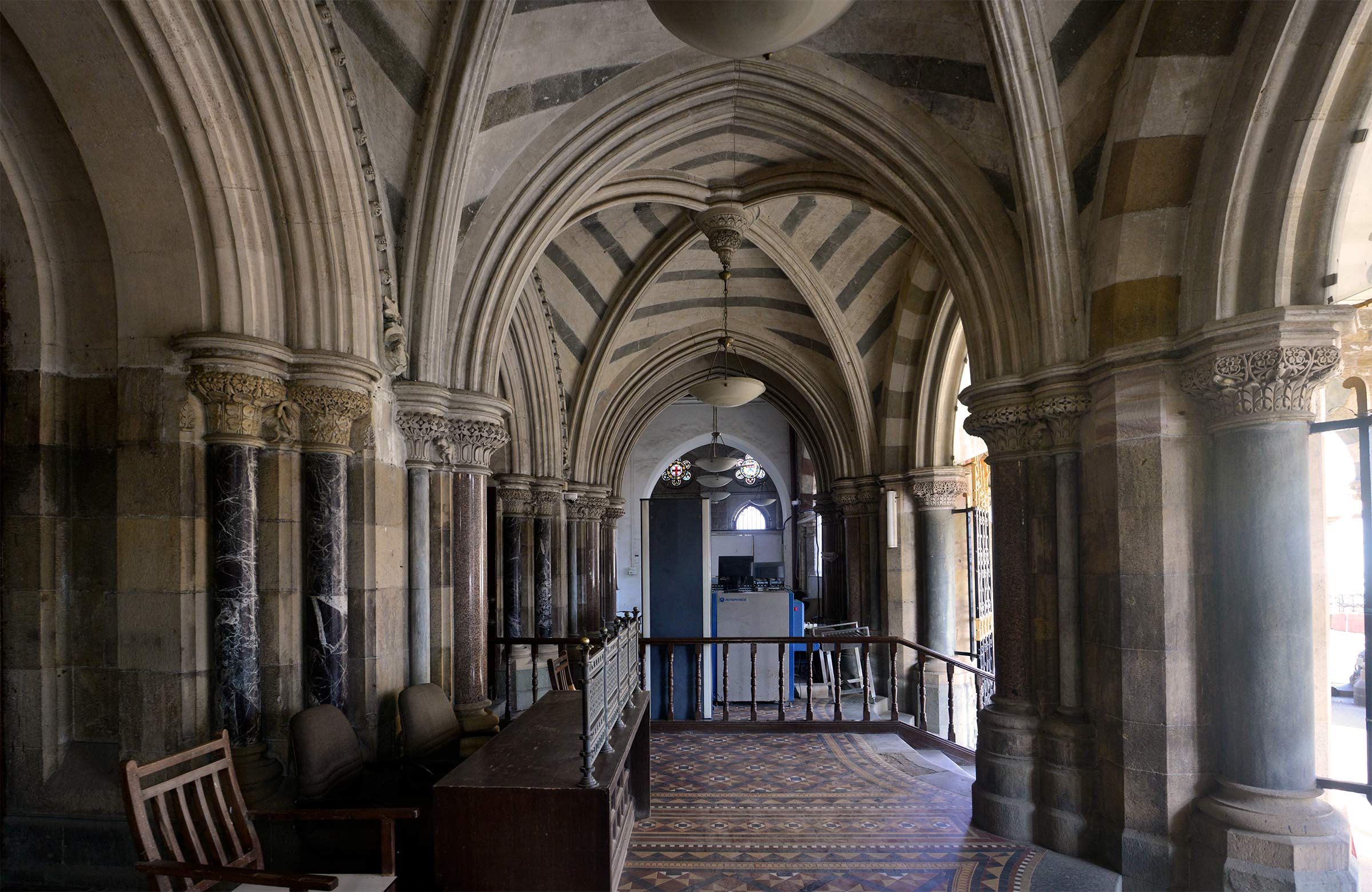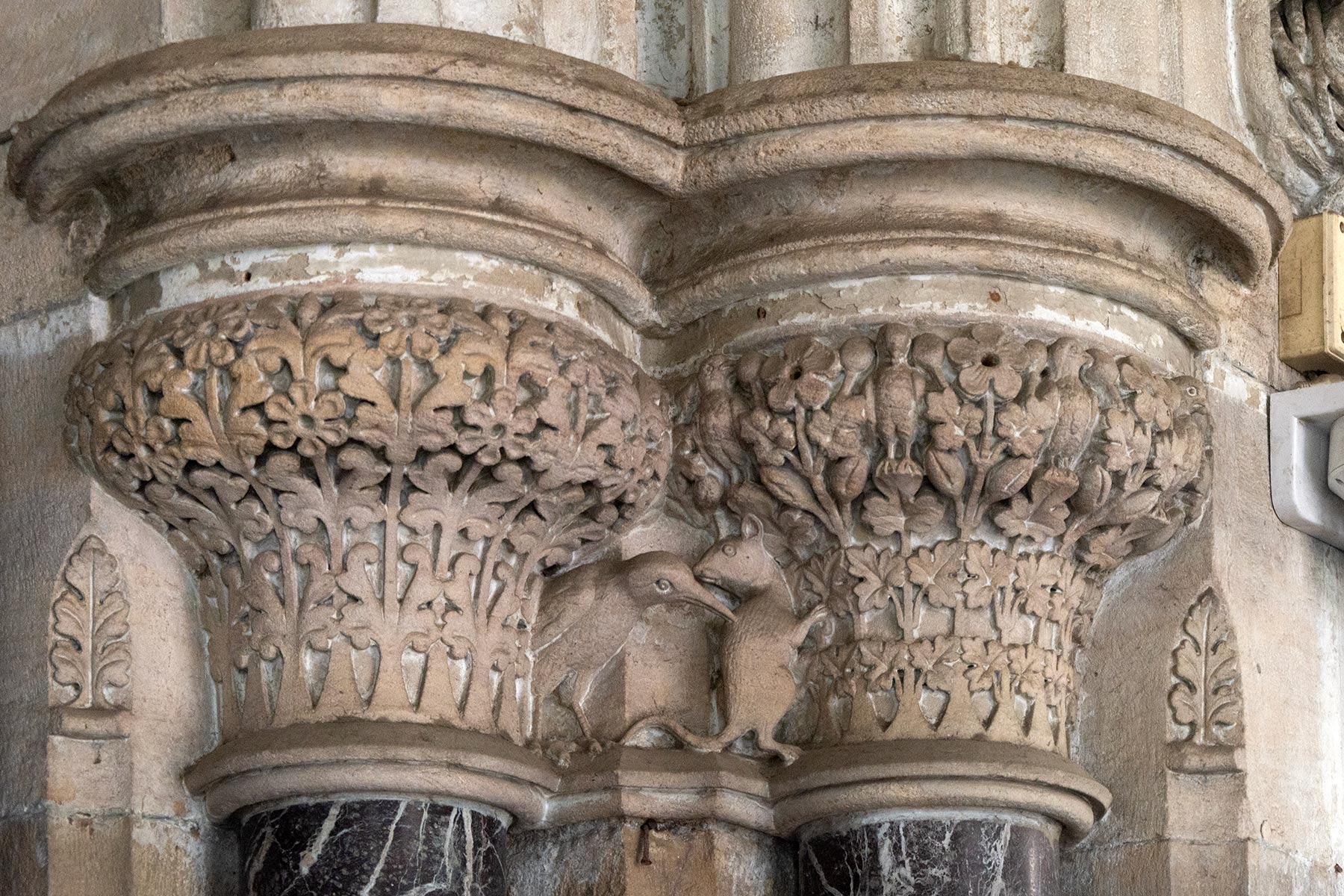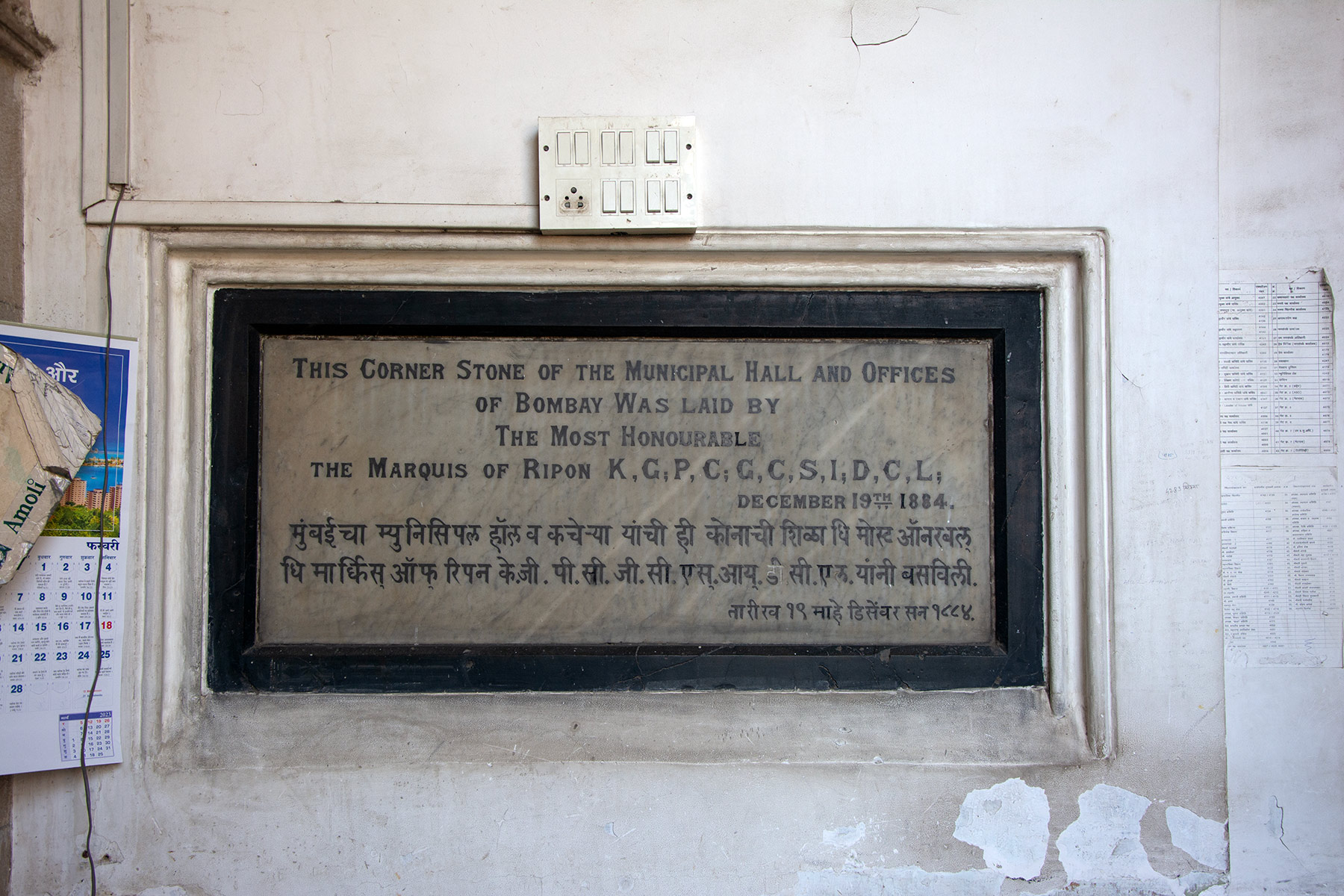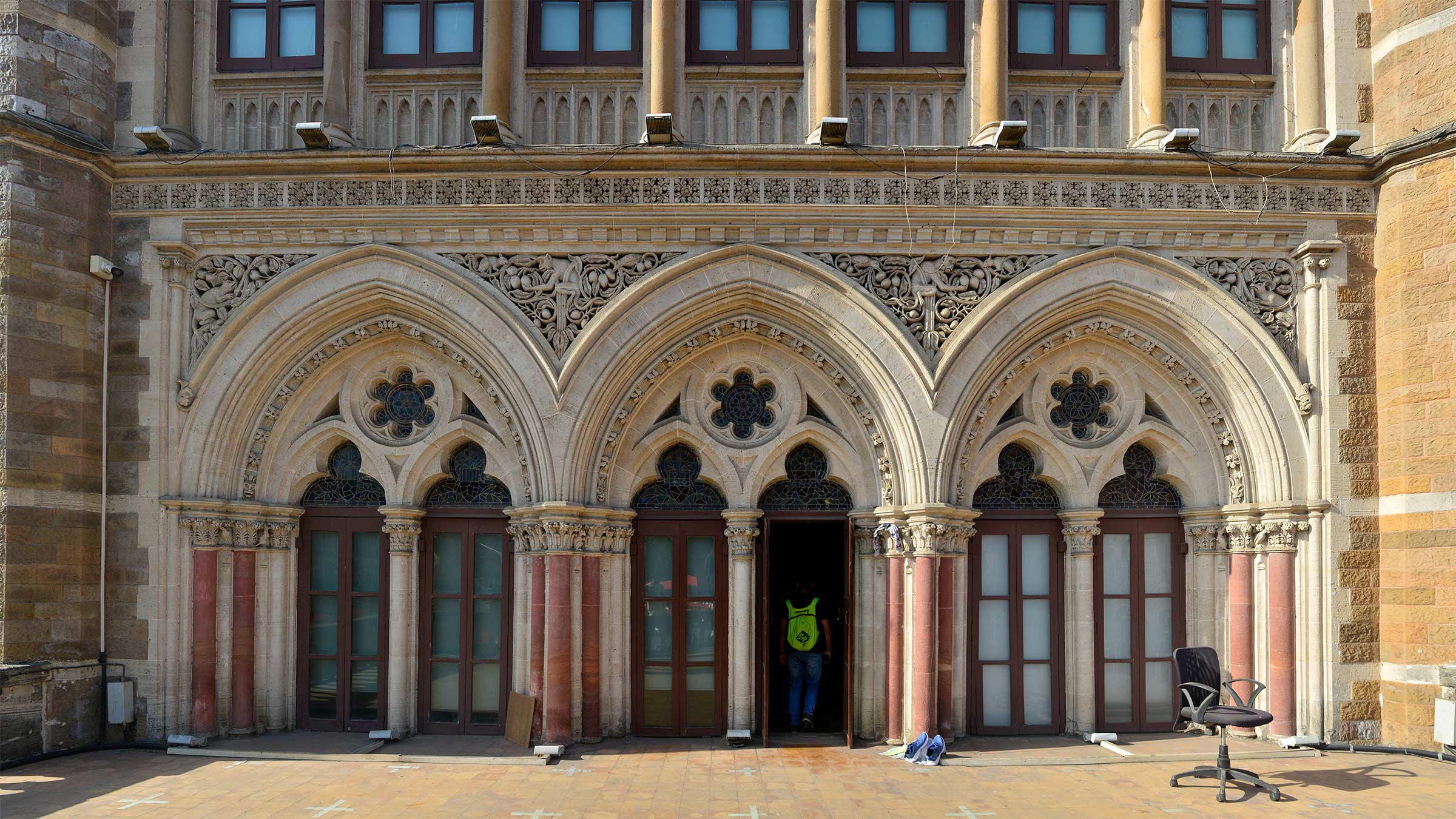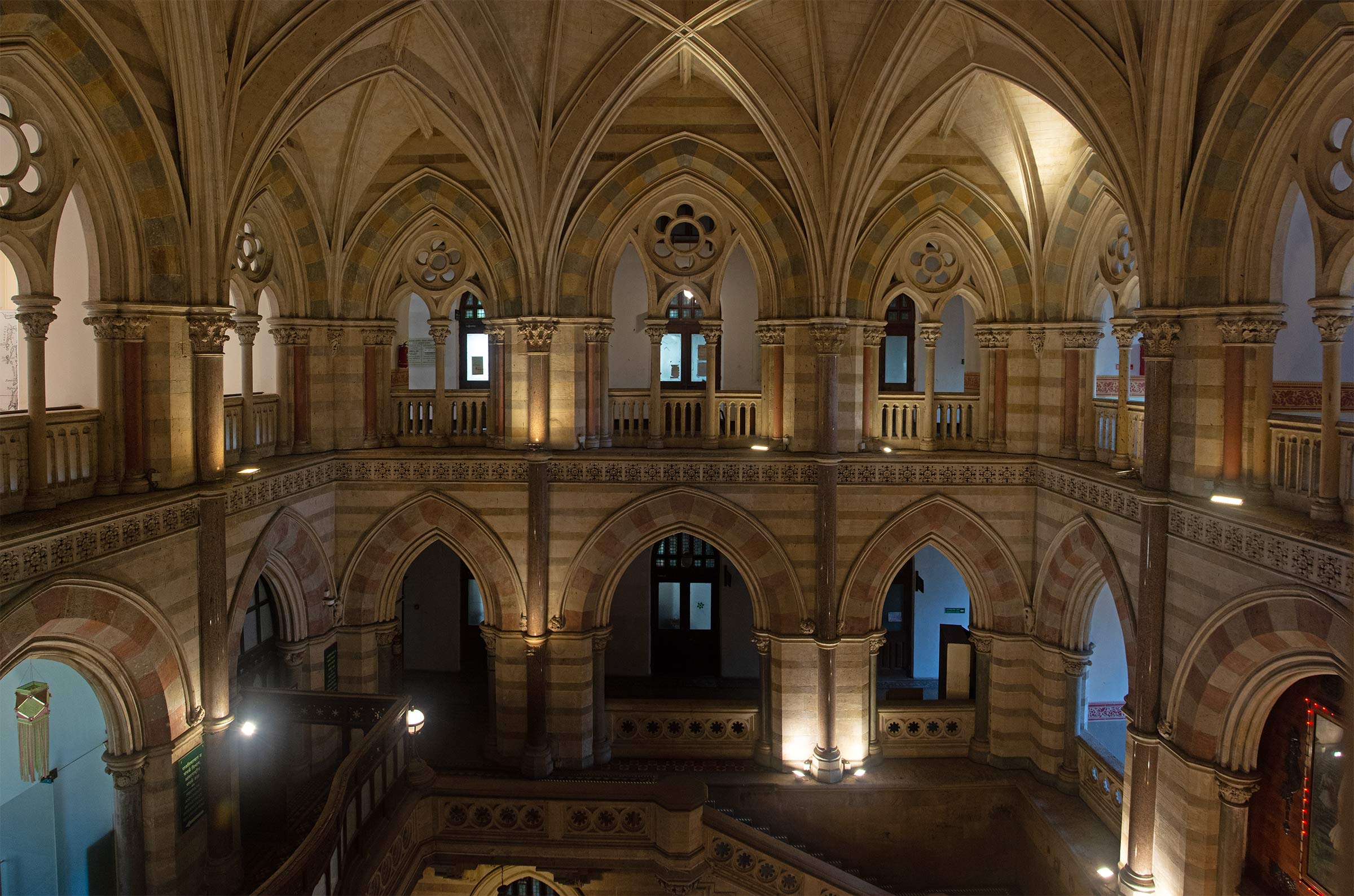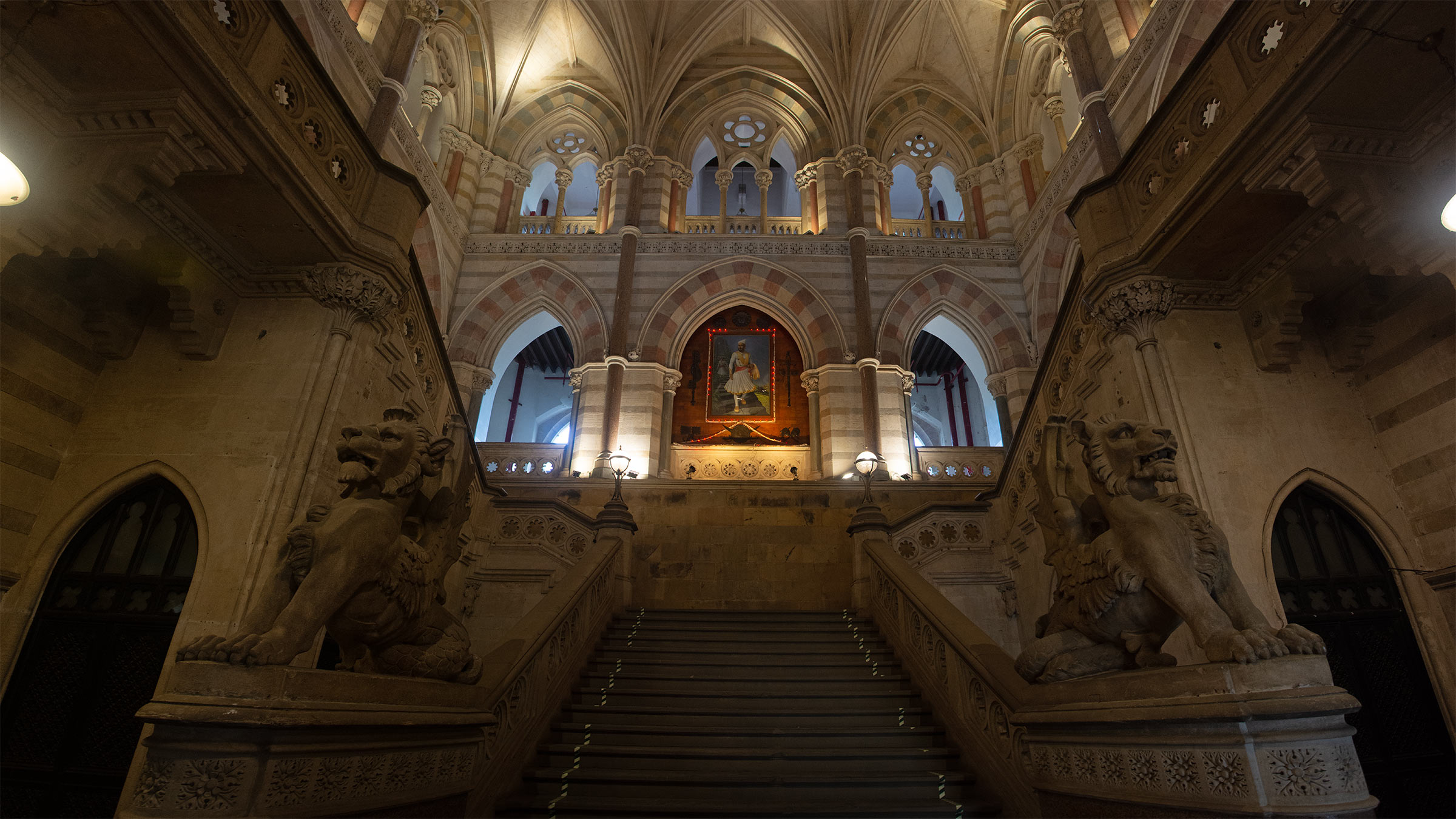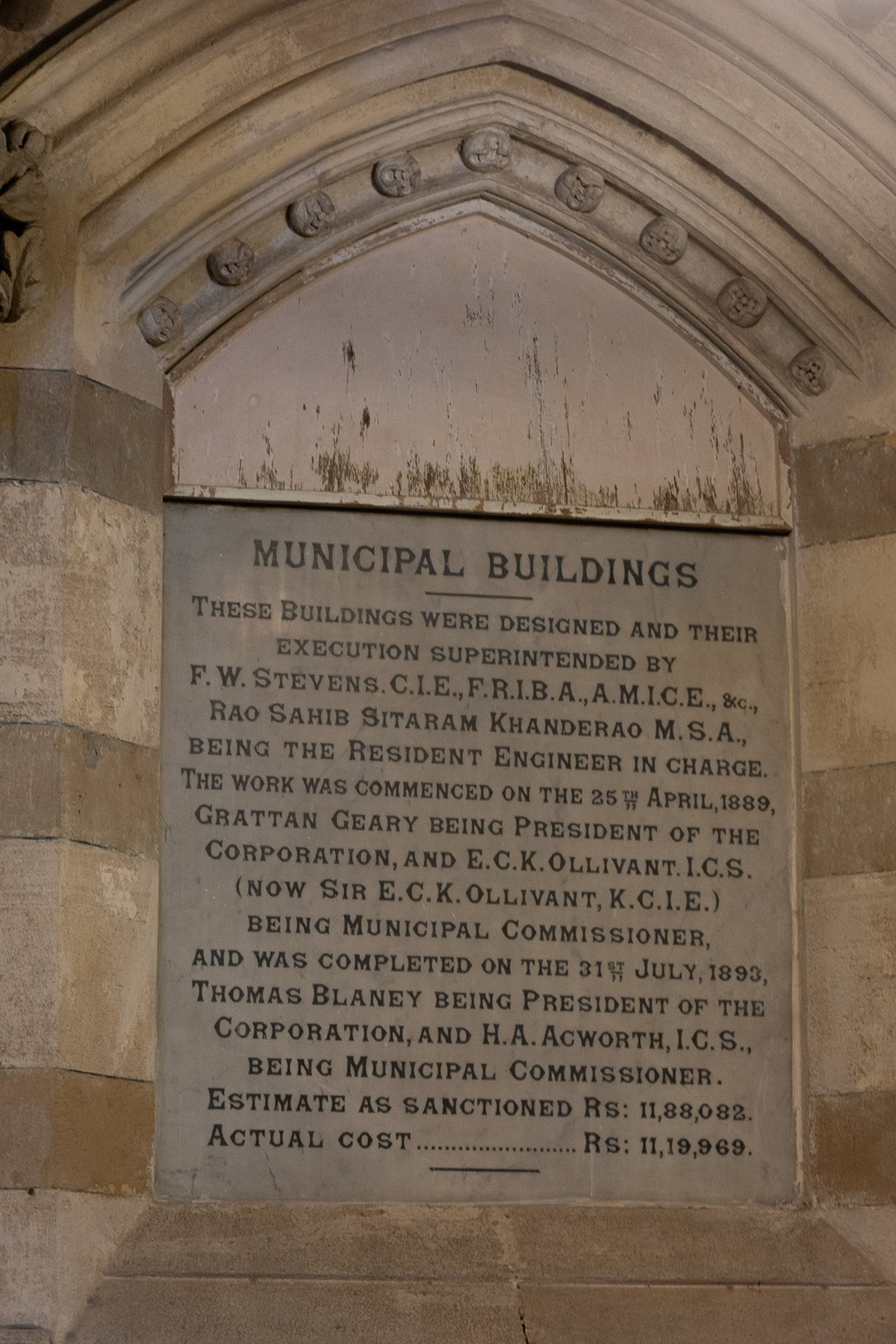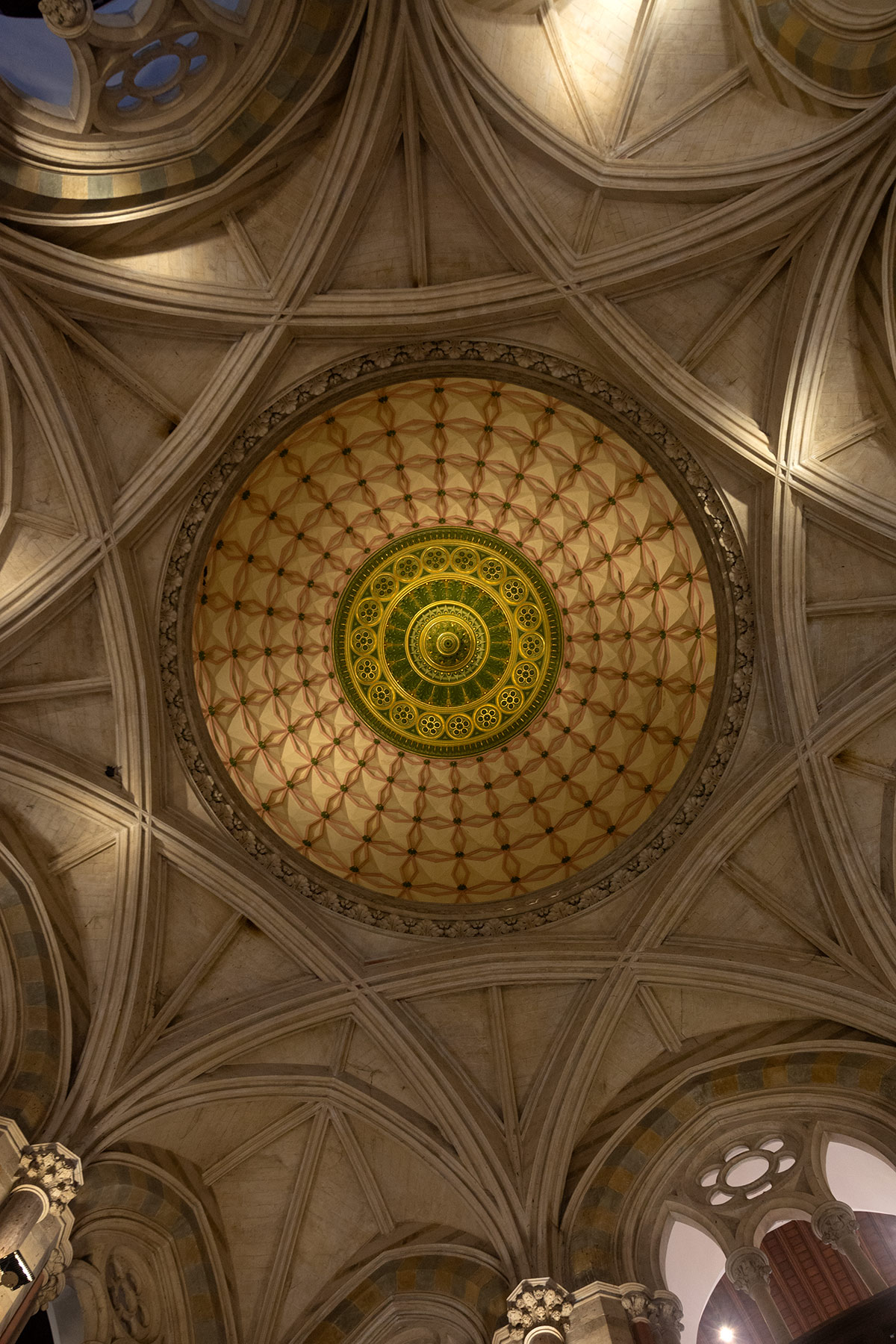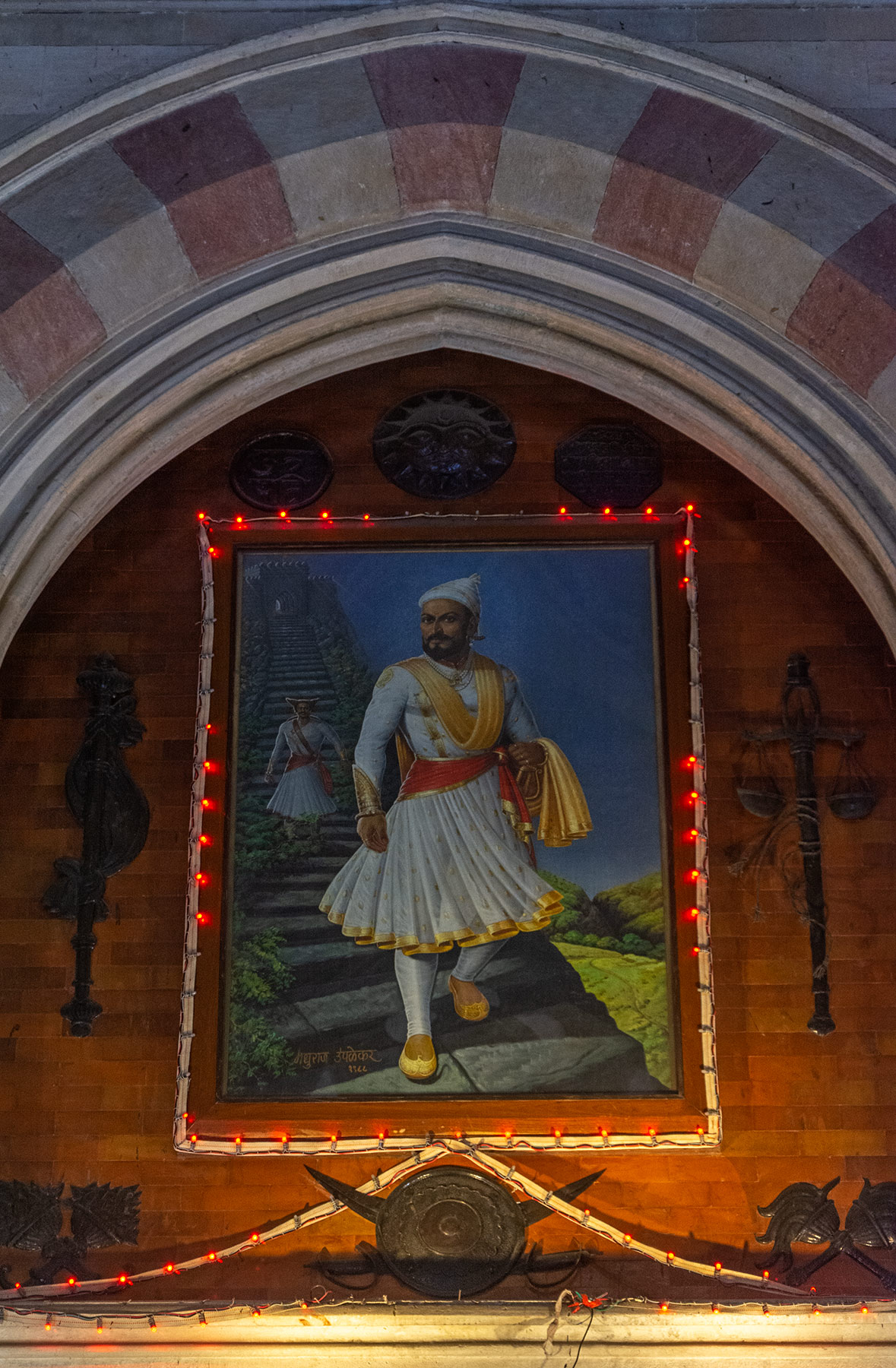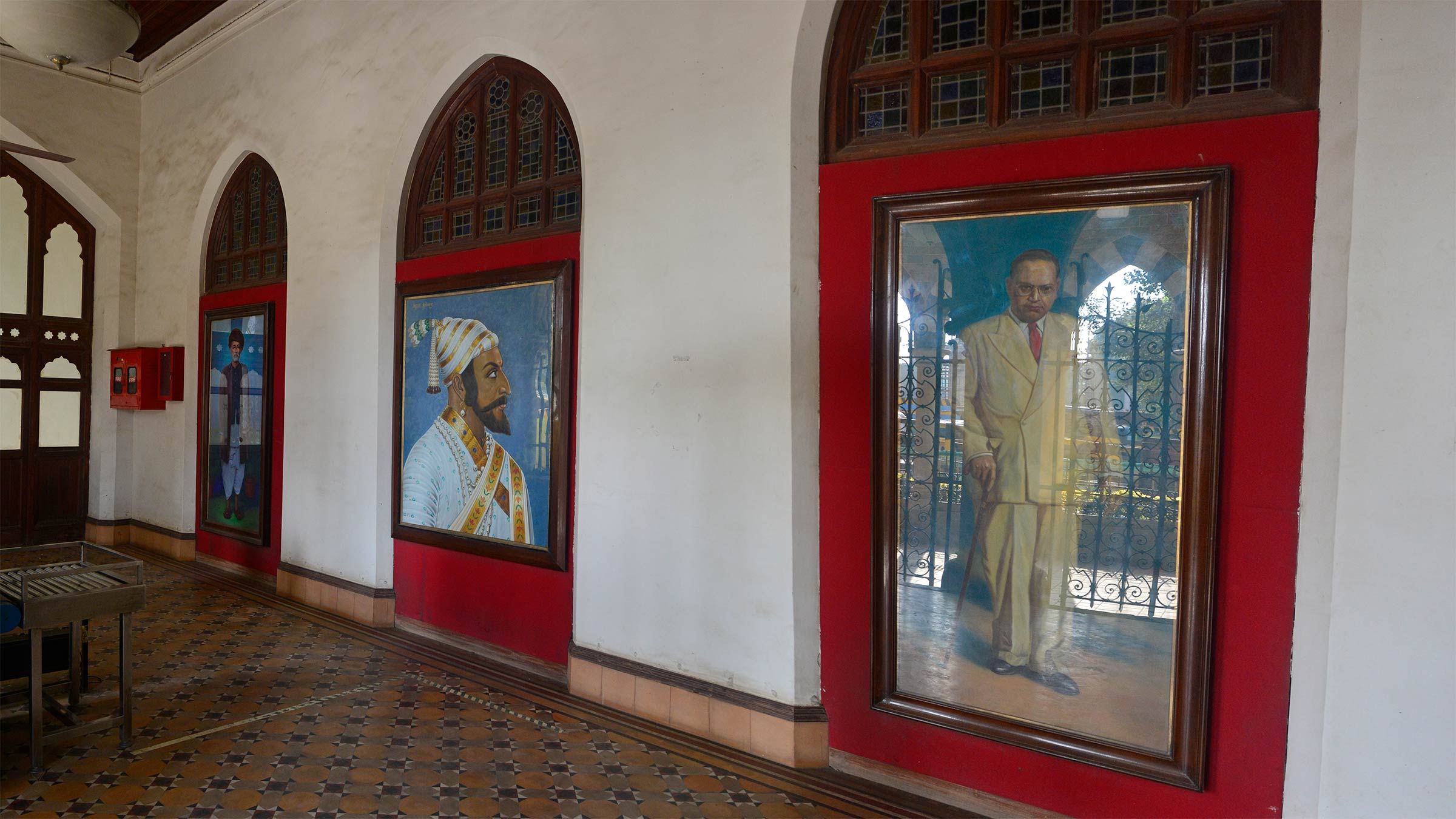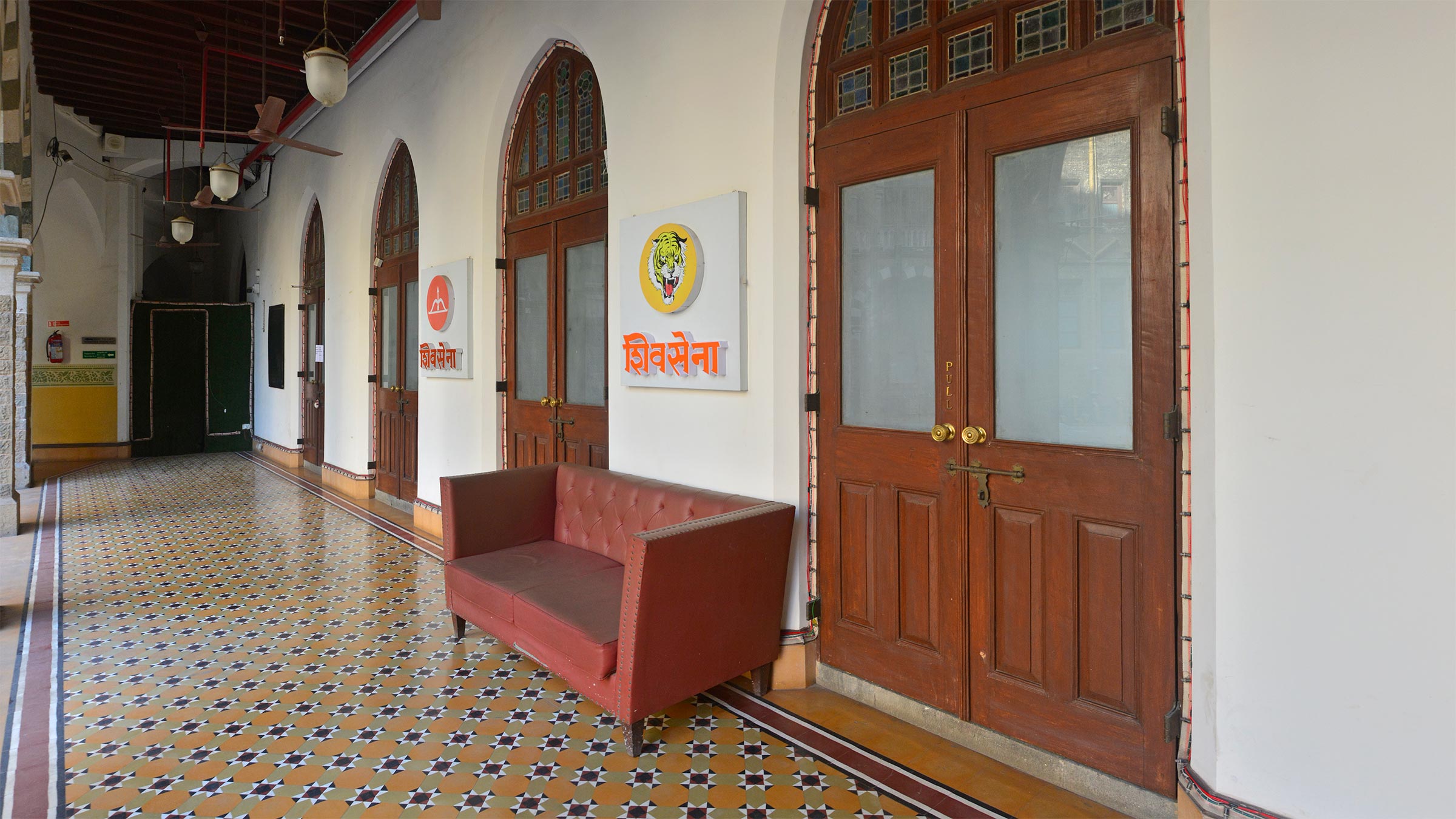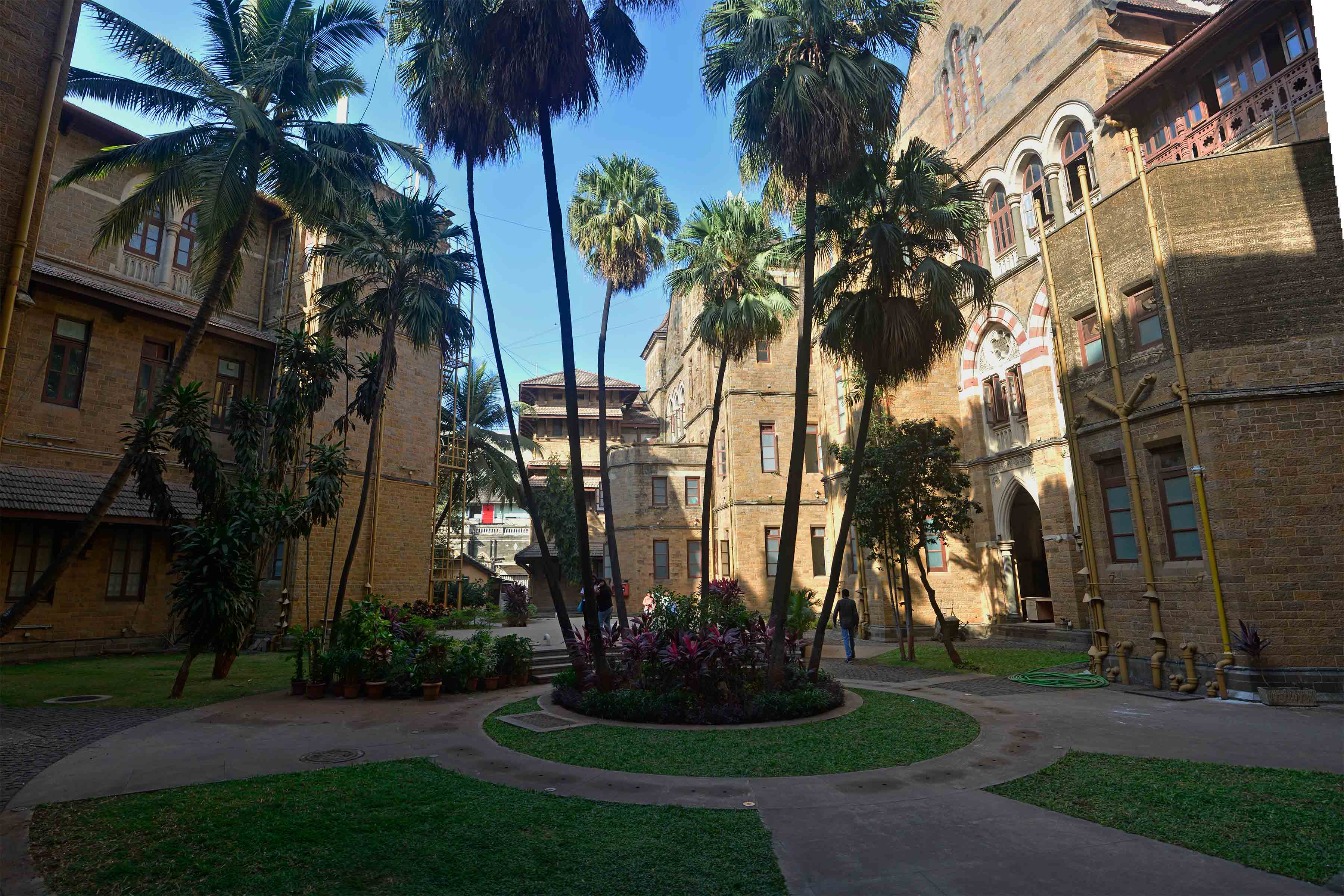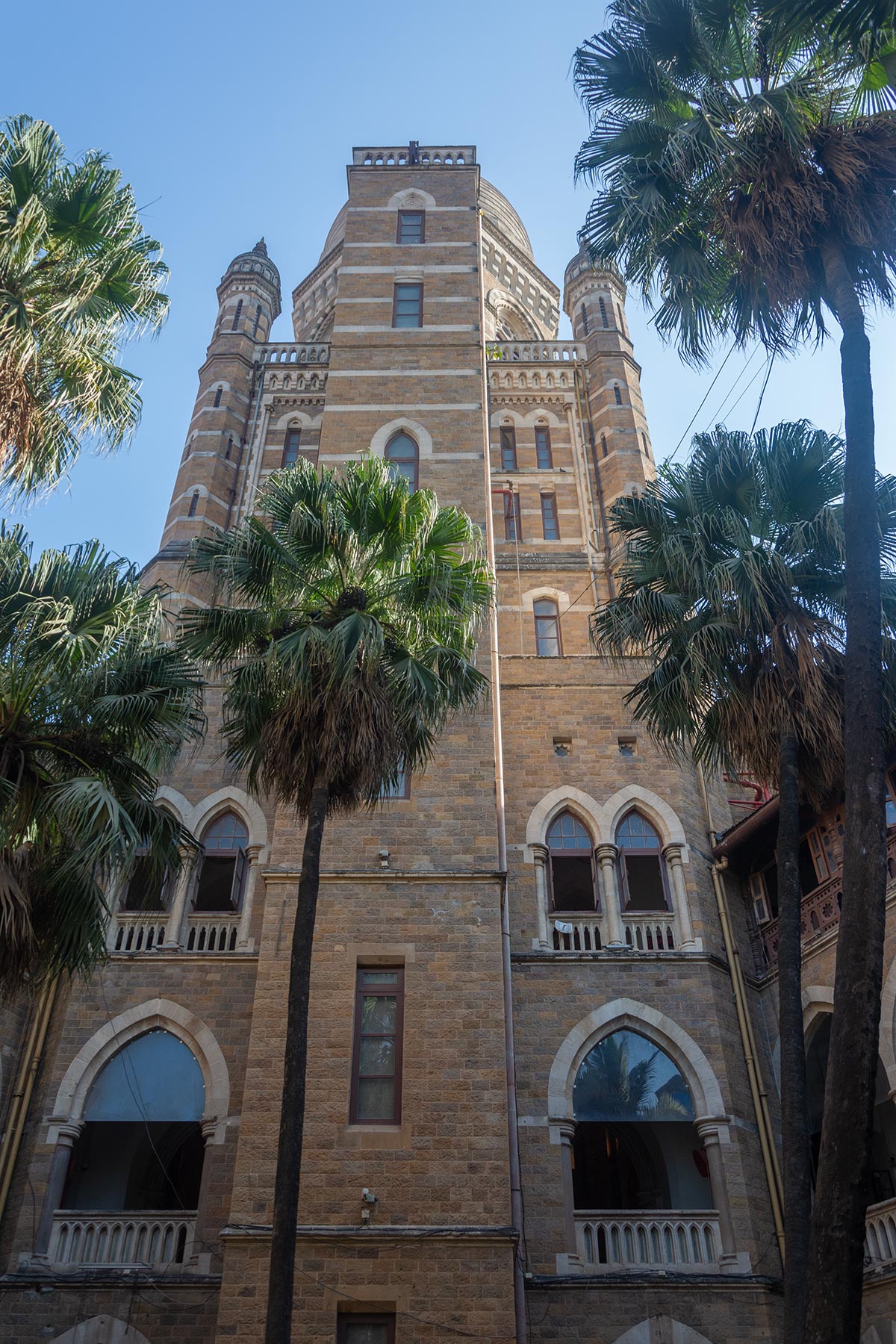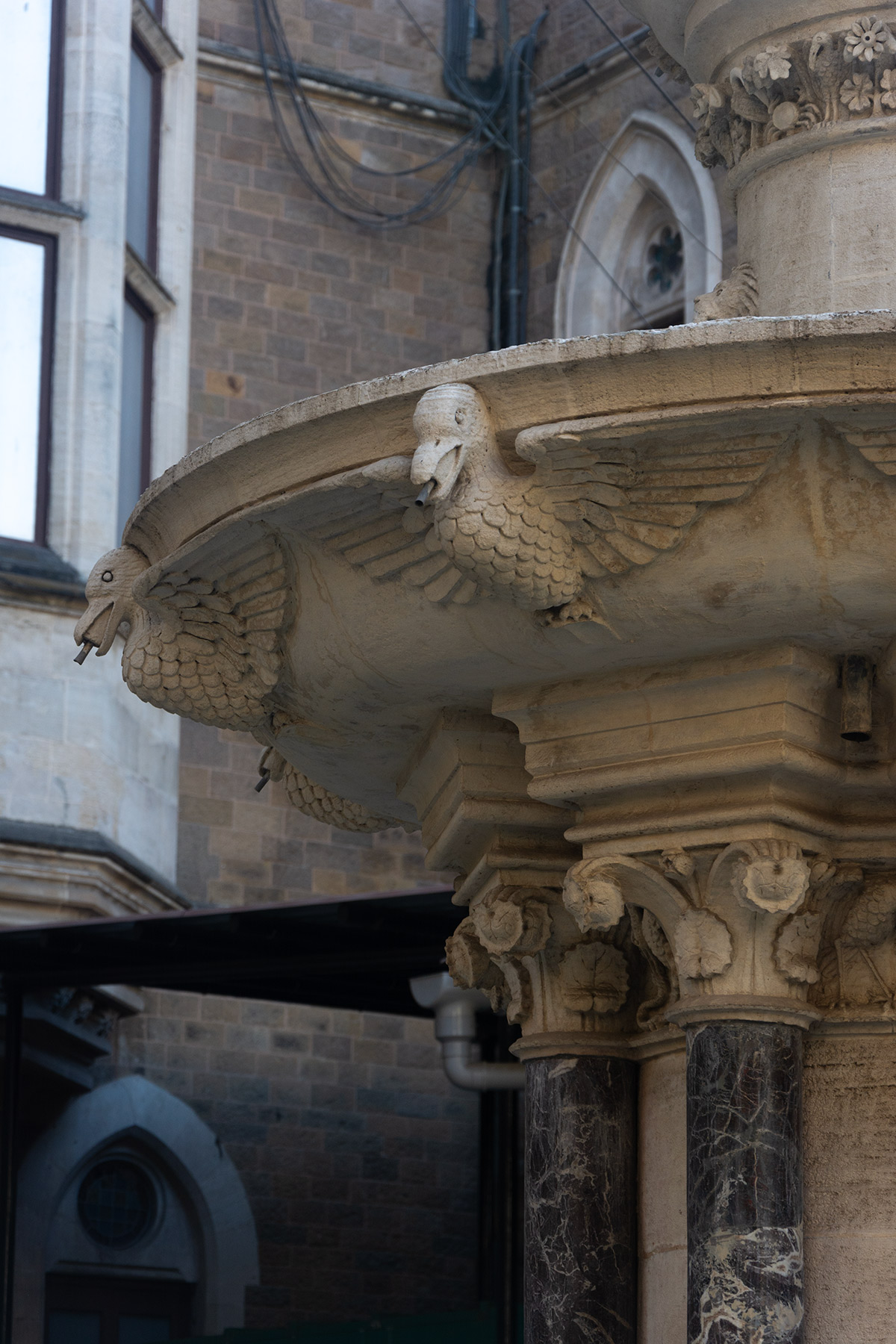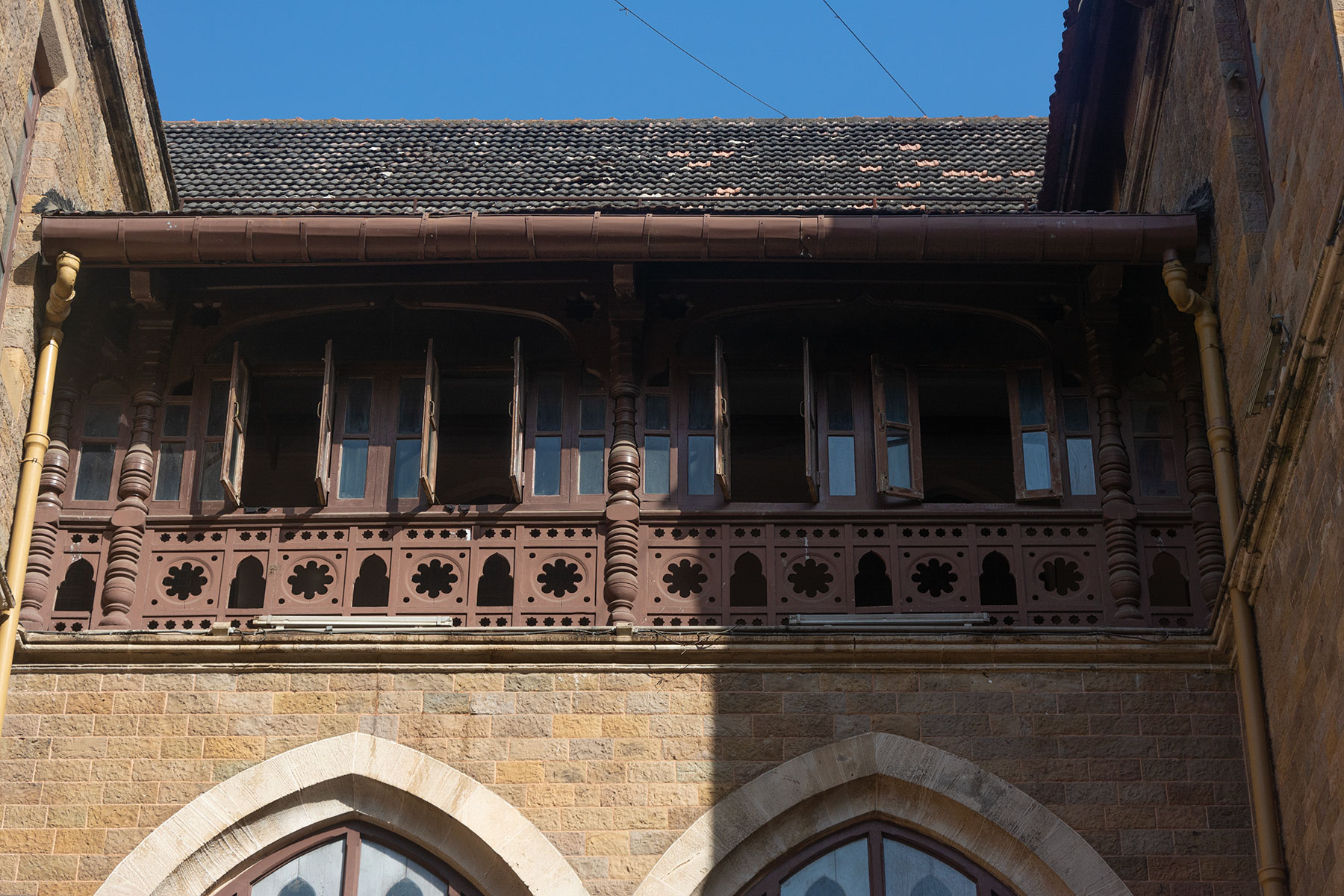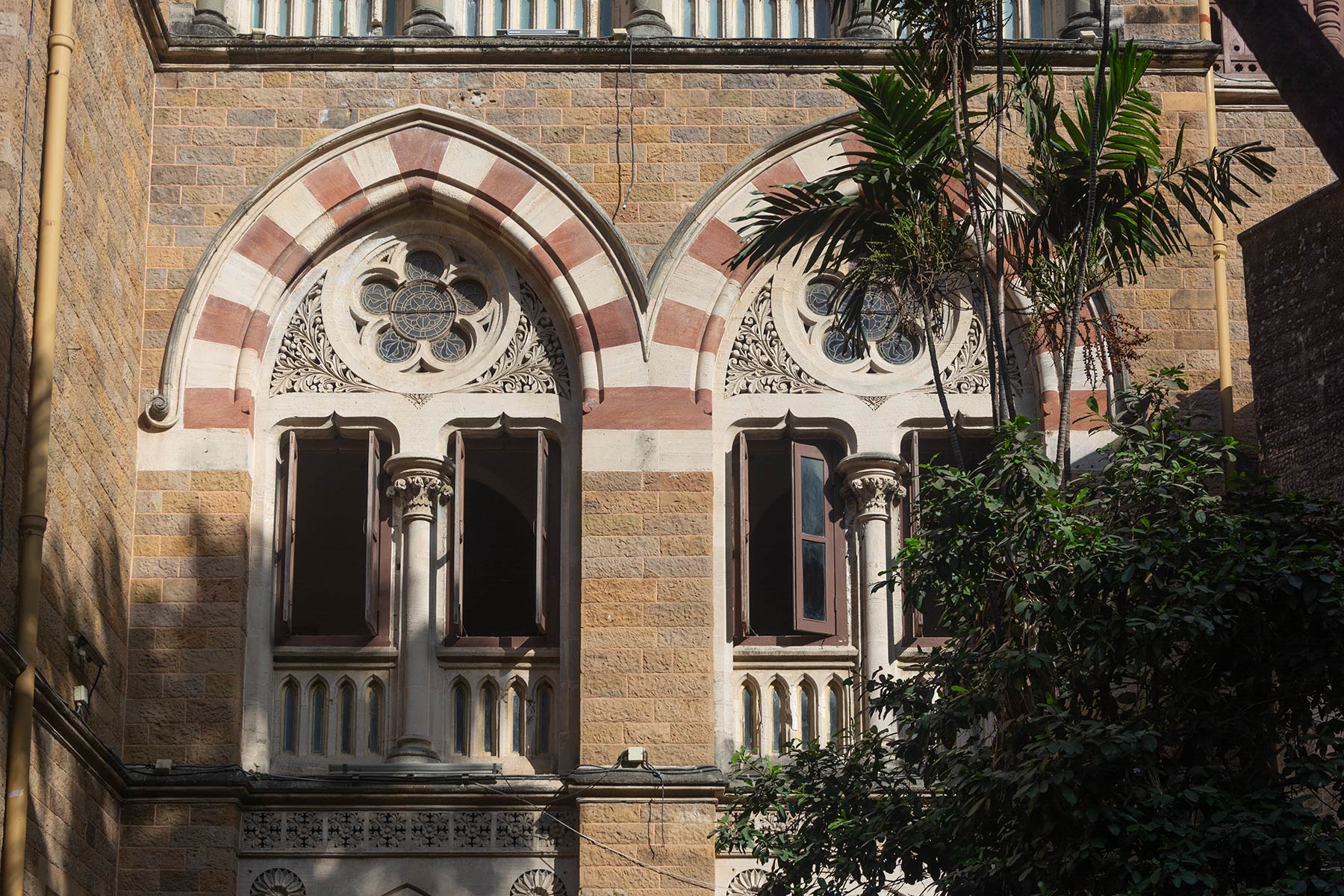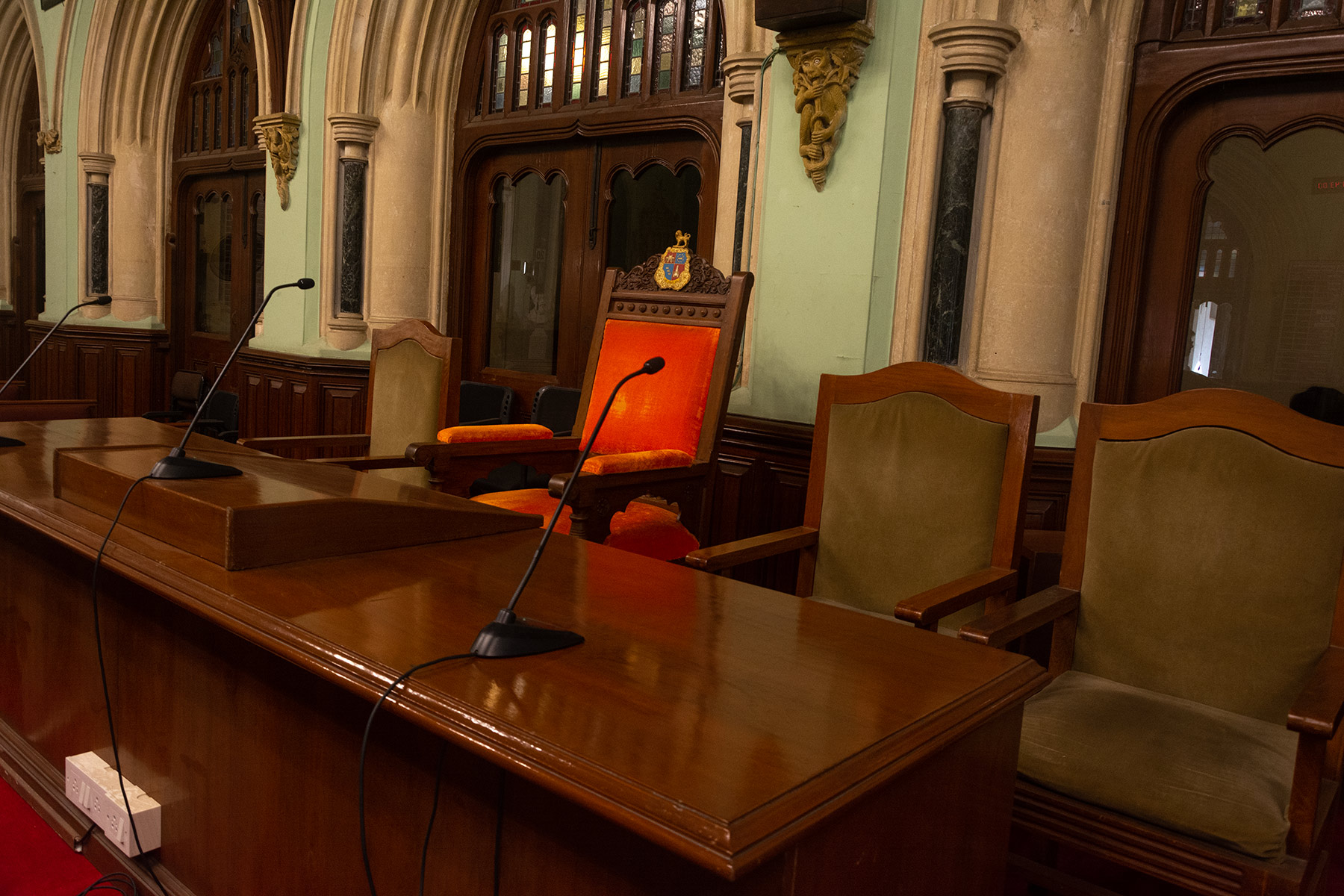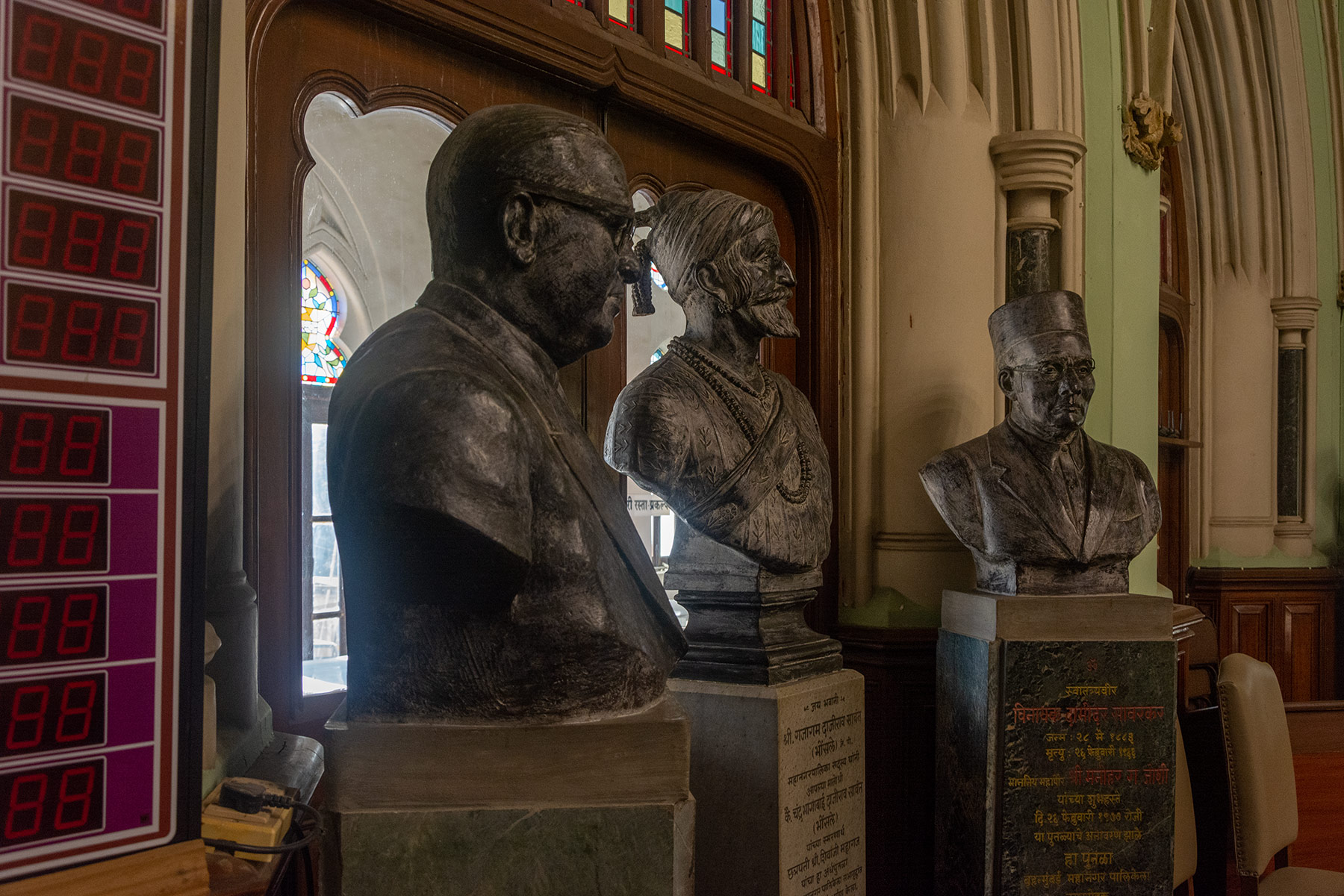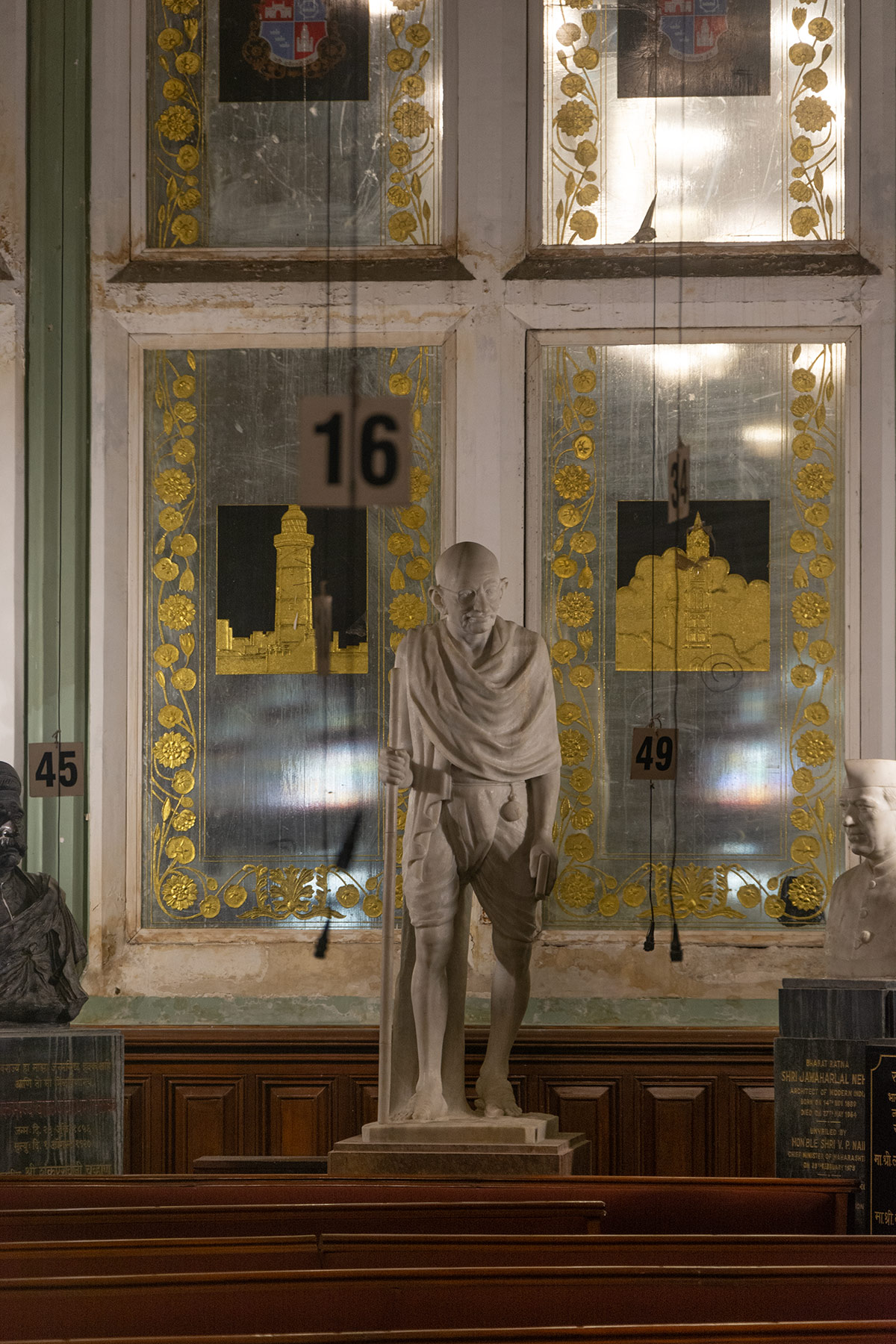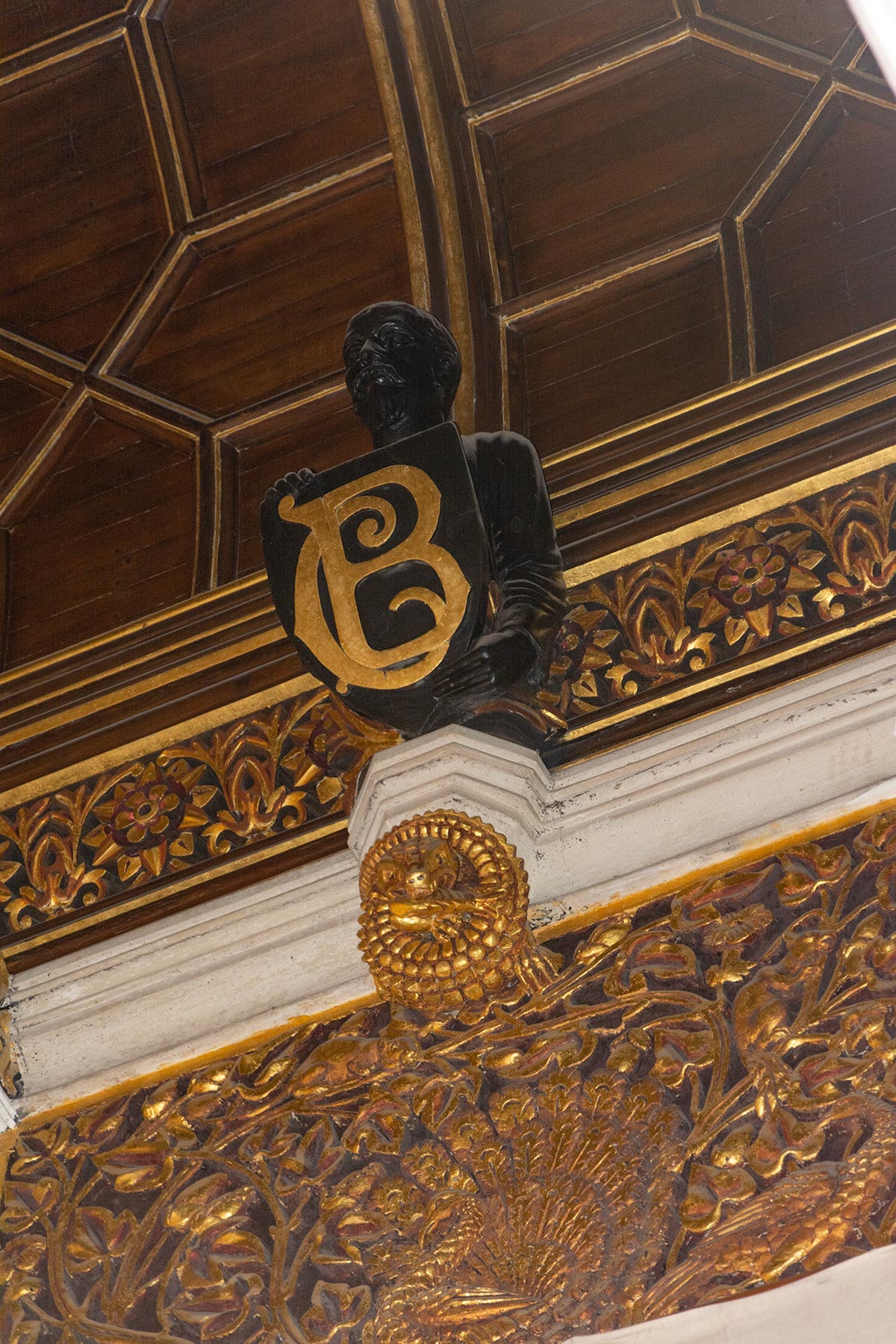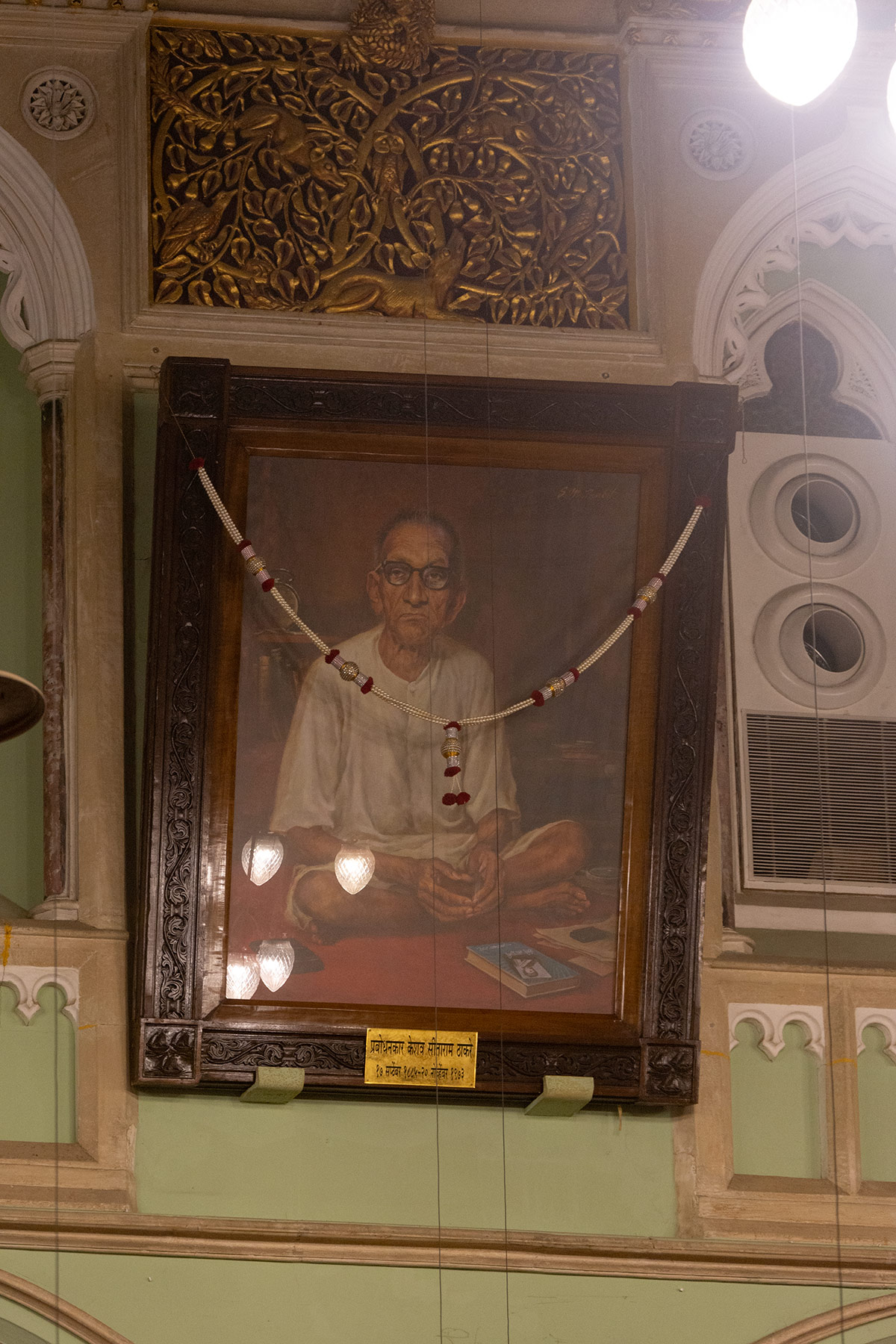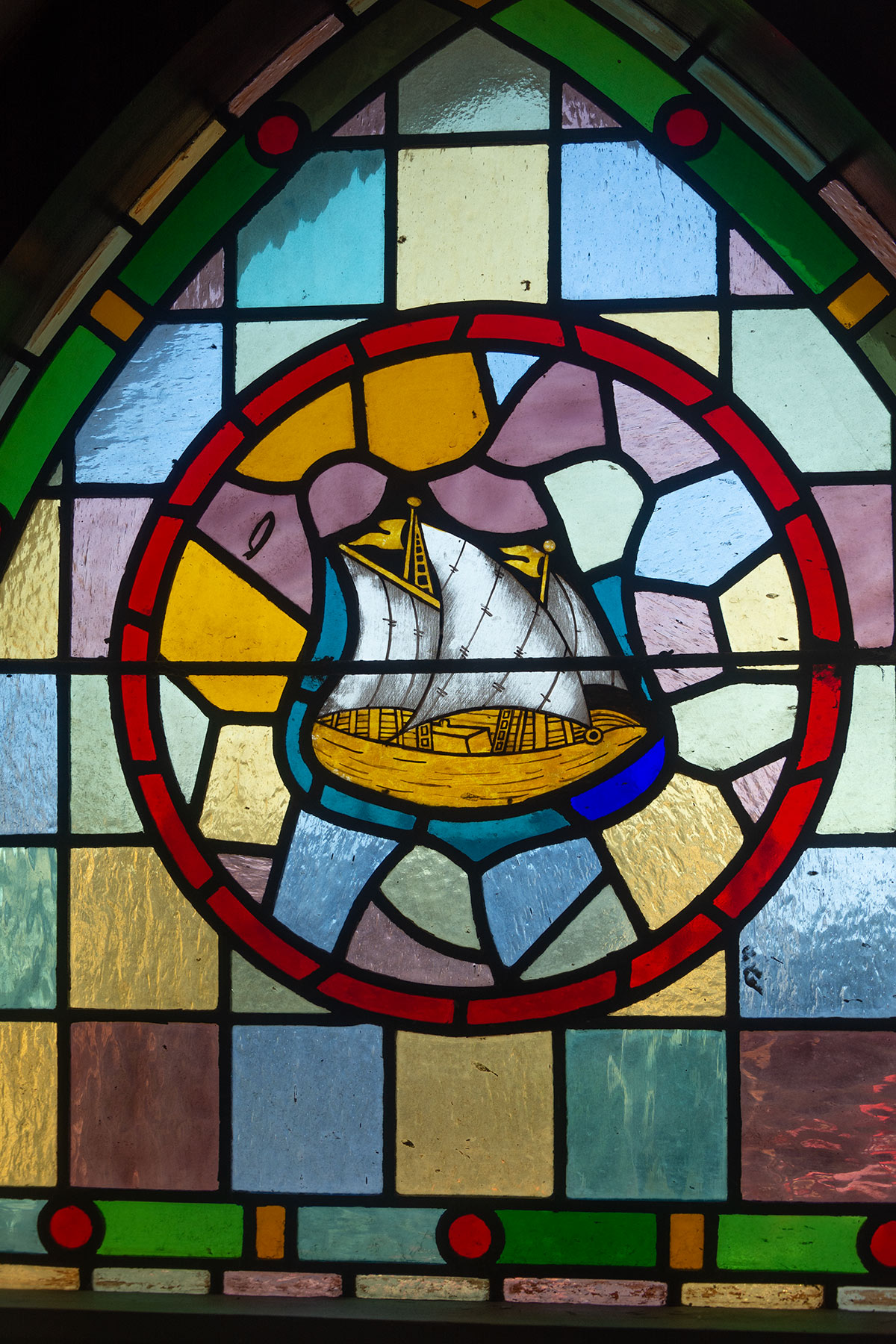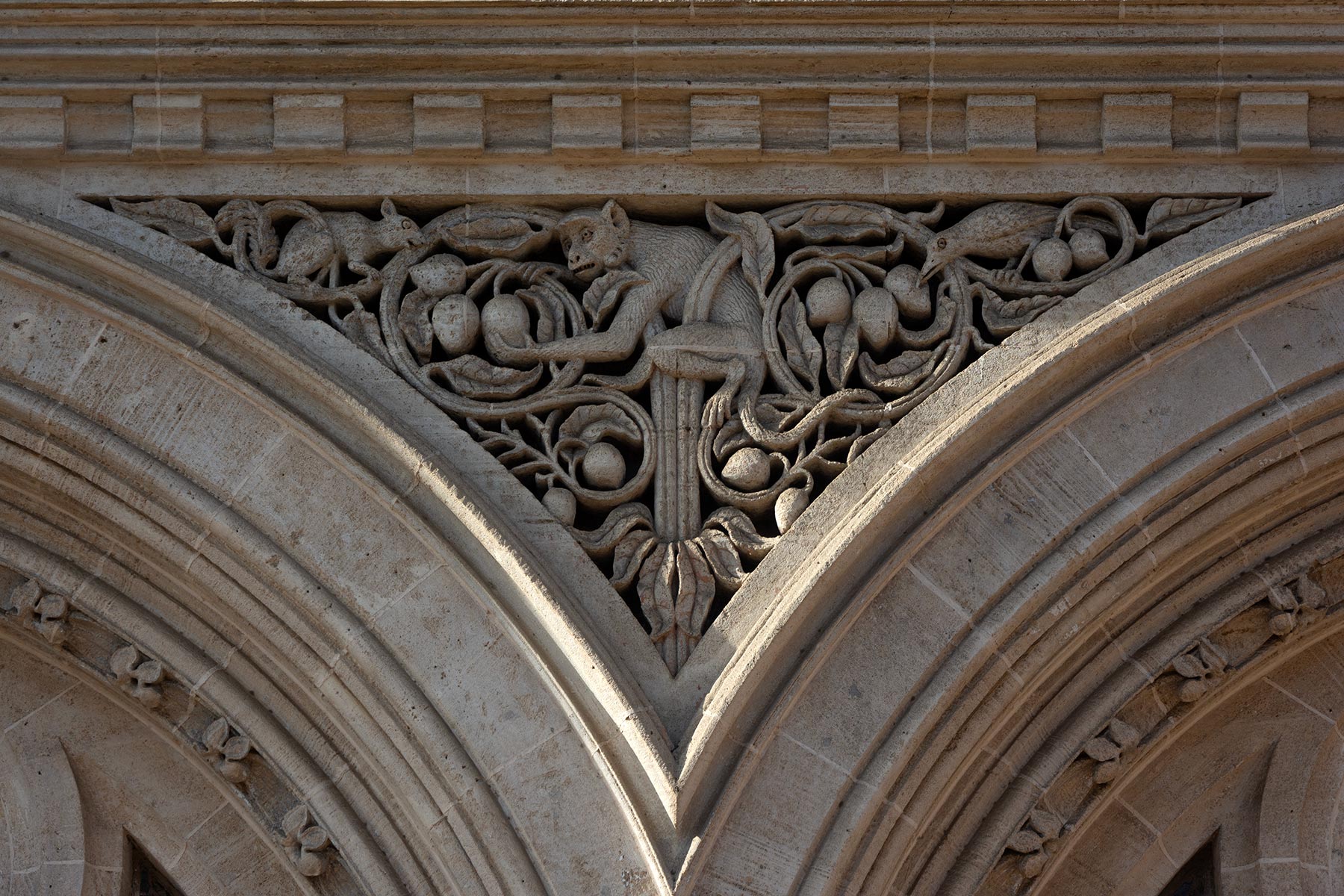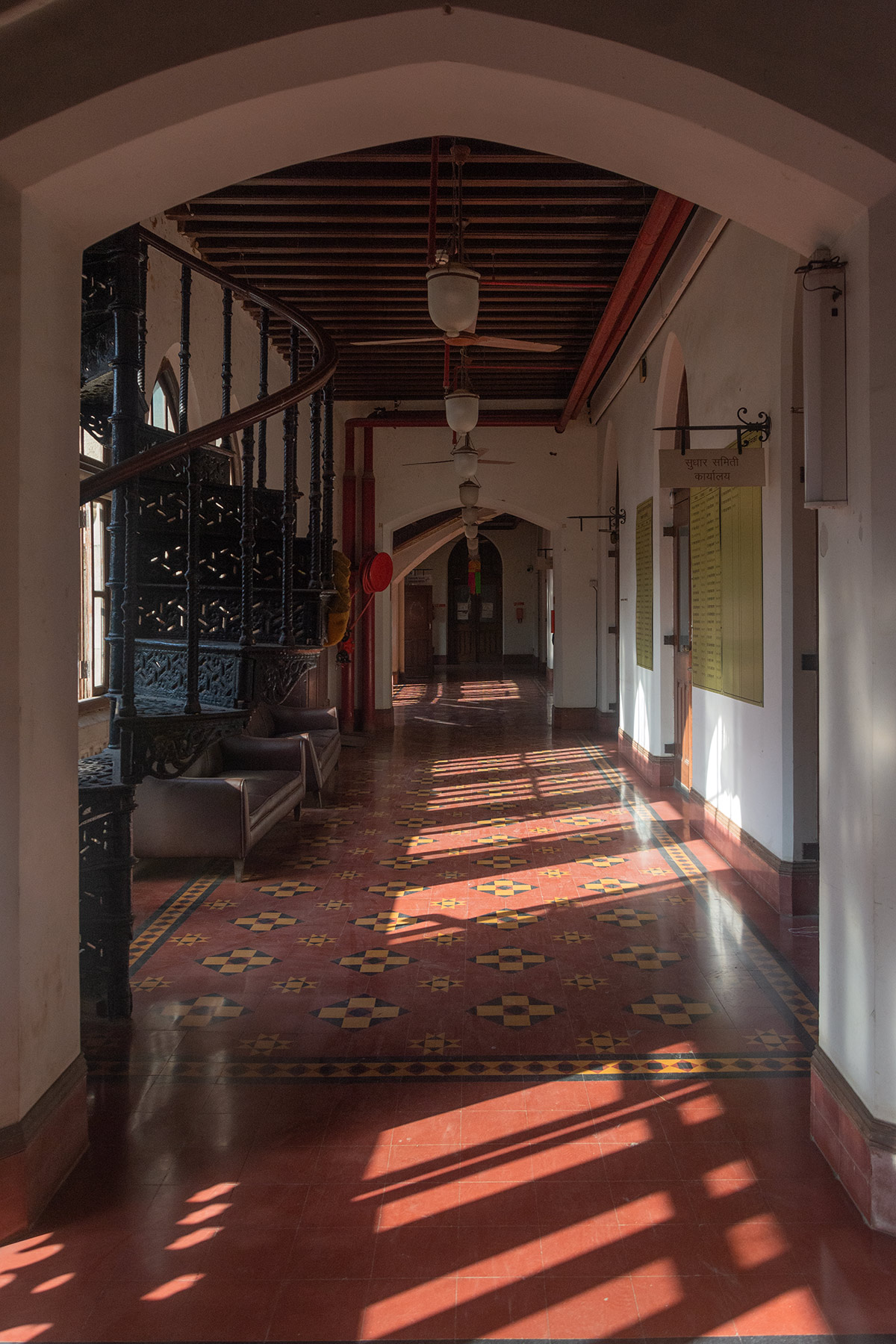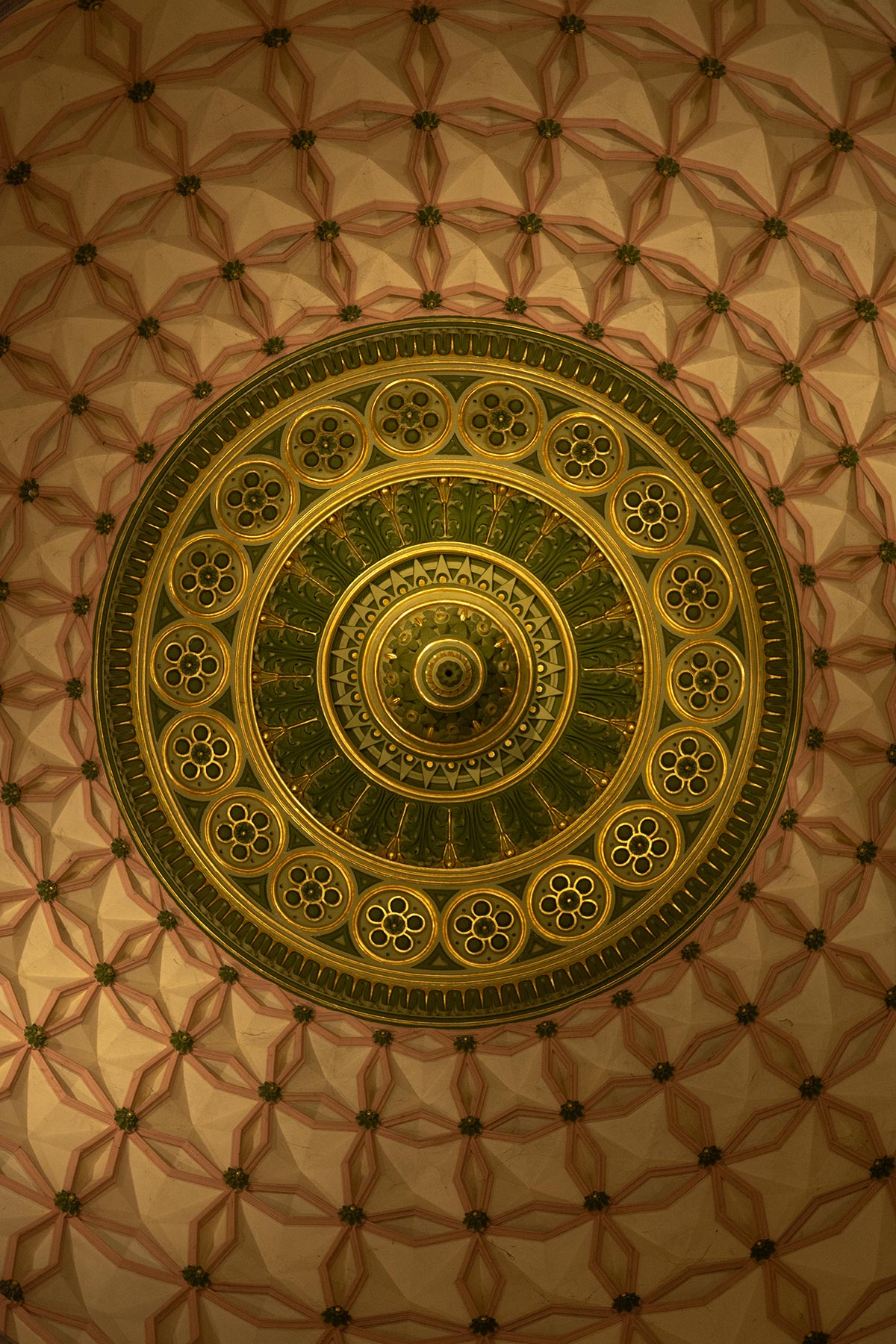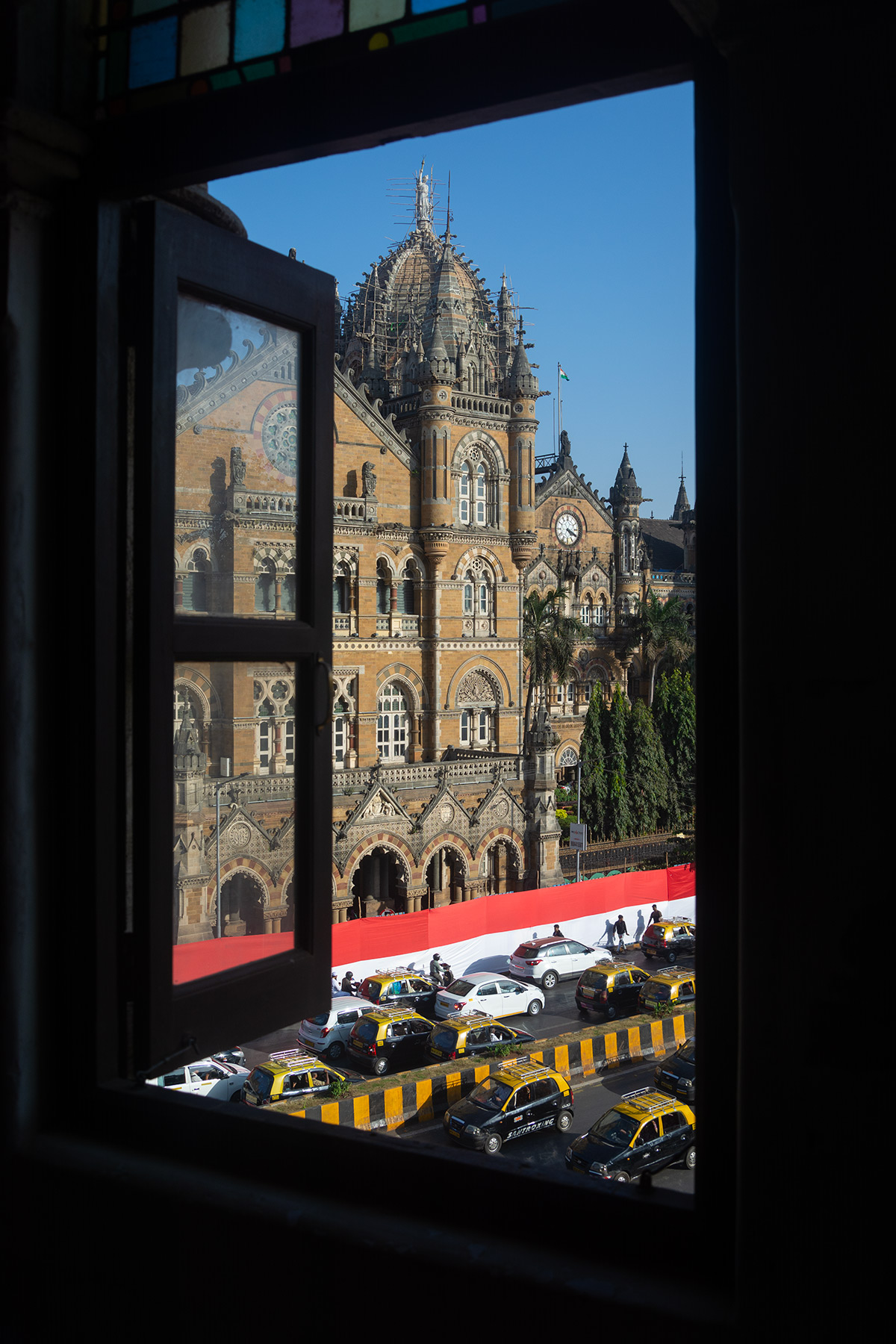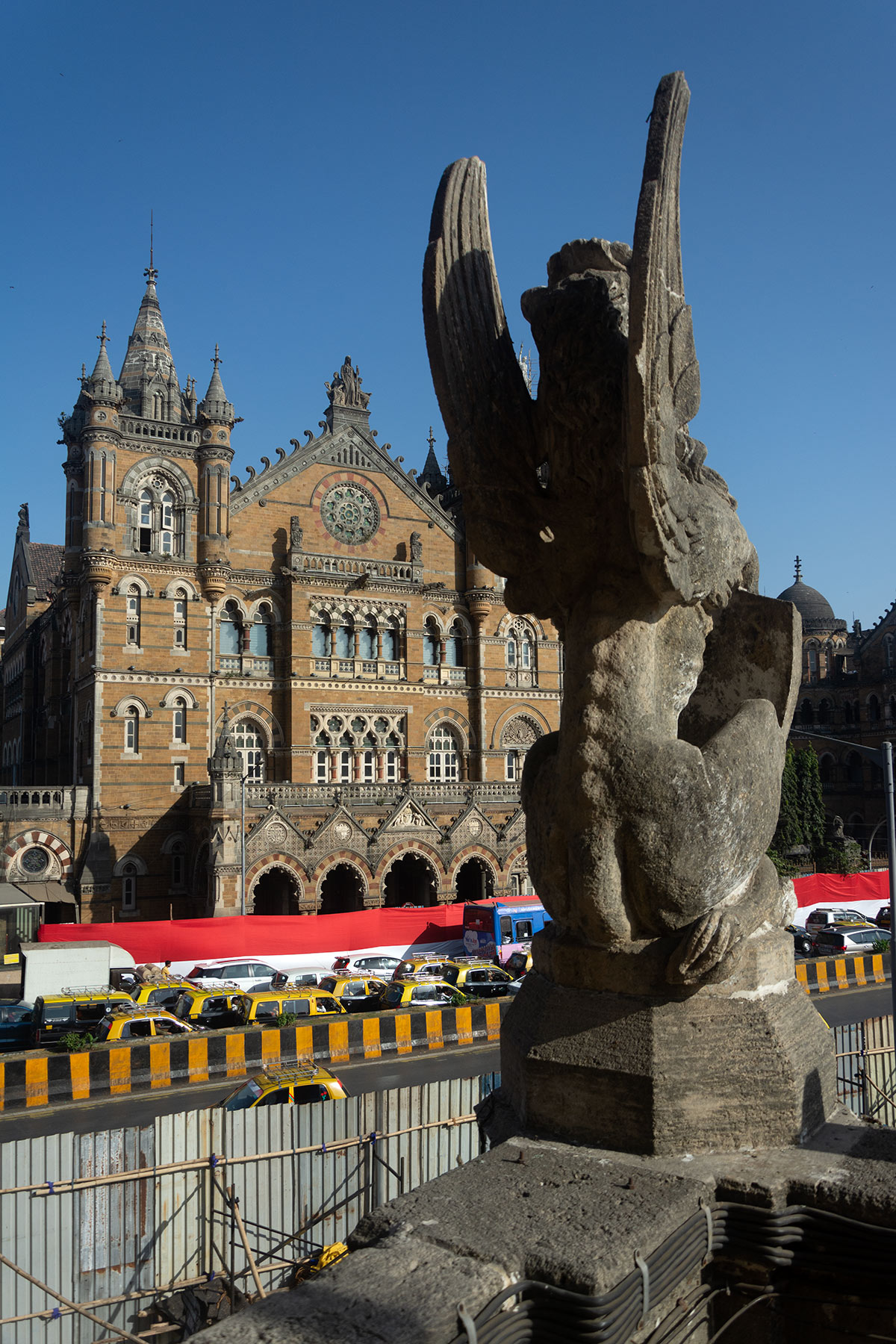Victorian Gothic at Brihanmumbai Municipal Corporation (BMC)
Brihanmumbai Municipal Corporation (BMC), also known as Municipal Corporation of Greater Mumbai or Bombay Municipal Corporation, is India's richest municipal corporation, responsible for developing and maintaining the city's civic infrastructure and tax collection. The Bombay Municipal Corporation Act established it in 1888. The headquarters are located in the BMC building, which is also featured on the corporation's seal (along with the Gateway of India).
V-shaped plot at intersection of Mahapalika Marg and DN Road
Bombay Municipal Corporation commissioned Frederick W. Stevens to design a new building to hold its offices. The offered site was a V-shaped plot located opposite Chhatrapati Shivaji Maharaj Terminus (CSMT, formerly Victoria Terminus), at the intersection of Mahapalika Marg (formerly Cruikshank Road) and Dadabhai Naoroji Road (formerly Hornby Road).
Statue of Sir Pherozeshah Mehta
A prominent member of the Parsi community in Bombay, Sir Pherozeshah Mehta drafted the Bombay Municipal Act of 1872 and is thus considered 'Father of Bombay Municipality'. He became municipal commissioner of Bombay Municipality in 1873 and its president four times—1884, 1885, 1905 and 1911. A statue of Sir Pherozeshah Mehta was installed in front of the BMC building in honor of his role in the establishment of the municipality.
The BMC building prominently displays the coat-of-arms of the Brihanmumbai Mahanagarpalika (Municipal Corporation of Greater Mumbai). A heraldic lion surmounts the four-panel shield, with a blooming lotus at its base. The Sanskrit motto यतो धर्मस्ततो जय: Yato Dharmas Tato Jayaḥ (Where there is righteousness, there shall be victory) is inscribed in gold at the bottom.
Facade of BMC building with coat-of-arms
Sir Bartle Henry Frere, governor of Bombay Presidency between 1862–67, demolished the ramparts of Fort George to allow Bombay to expand beyond the fort walls. As the city limits expanded, there was a need for a municipality to overlook the suburban civic infrastructure development. The Municipal Corporation of Greater Mumbai established itself in 1865 and appointed Arthur Crawford as its first municipal commissioner.
Allegoric figure of urbs primus in indis
Frederick W. Stevens used allegorical figures to represent concepts like progress and prosperity. This, for example, is a Christian motif of a winged angel holding up a miniature ship to highlight Mumbai's association with maritime trade. The allegoric figure represented is urbs primus in Indis (Latin for the ‘primary urban city of India’), which was adapted as the motto of the Brihanmumbai Municipal Corporation.
Central tower and dome of the BMC building
Public buildings in Mumbai adopted architectural styles that were popular in Europe until the mid-nineteenth century. Notable among them were the Neo-Classical and Gothic Revival styles. By the time Frederick W. Stevens started working in Mumbai, in 1869, a new eclectic form was gradually taking shape that incorporated European forms mixed with Indian elements inspired by Hindu and Islamic architecture. This new style came to be known as Indo-Saracenic.
Indo-Saracenic domes on the BMC building
The Indo-Saracenic style developed by British architects used motifs inspired from Mughal architecture and those of the Deccan Sultanates, from monuments built by the Adil Shahis (Bijapur) and Qutub Shahis (Hyderabad), to make them look more ‘Indian‘. A prominent adaptation by Frederick W. Stevens was the use of the onion-shaped dome with finial on top, which appears in buildings designed by him, including at the BMC.
BMC offices along Mahapalika Marg
Bartle Frere had envisioned Mumbai as urbs primus in Indis as early as the 1840s, when he collaborated with architect Henry Conybeare for building the Afghan Church at Navy Nagar, Colaba. His vision of Mumbai as India's prime city set in motion the Gothic Revival phase, which reached its peak under his patronage and in the last decades of the nineteenth century.
Detail of porte cochere on Mahapalika Marg
Frederick W. Stevens designed the CSMT and BMC buildings within a decade of each other. As a result, both buildings have common features, design elements, and building materials. Stevens described his building style as ‘...a free treatment of early Gothic with an Oriental feeling, which, I consider, is the best adapted for the site the buildings are to occupy.’
Frederick W. Stevens was primarily influenced by Gothic architecture, and most of his projects were executed in Gothic. Within the Gothic genre, Stevens had a particular liking for Venetian Gothic, which originated in Italy in the 12th century. Stevens, inspired by Venetian Gothic, used stained-glass windows extensively throughout the BMC building.
An important design element Frederick W. Stevens borrowed from Venetian Gothic architecture was the use of a flower-shaped oeil-de-boeuf (ox-eye window in English), which let in natural light during the day. Though strictly not a window, because it was covered in stained glass, this circular opening is typically placed in a roof slope as a dormer or above a door or pair of windows (as seen here).
Gargoyles are another design element Frederick W. Stevens incorporated from Venetian Gothic architecture. Gargoyles, chimeras and griffons became very popular motifs in cathedrals, churches and castles in the Middle Ages in Europe. In Mumbai, they appear extensively in many of Stevens’ buildings, notably more at CSMT. At the BMC building, they are used sparingly, perched on top of turrets.
Chimera holding heraldic shield
Though they are mistaken as lions, the 'lions' at the BMC building are chimeras—a mix of various animals—hence they appear with wings and a serpentine tail. The chimera has been attributed to the British dominance over land, sea, and air. However, it is more likely that the motif was inspired by the flag of the Republic of Venice, which featured winged lions, one of the many elements Frederick W. Stevens incorporated from Venetian Gothic architecture.
Porte-cochere at the intersection of Mahapalika Marg and DN Road
The BMC building's main entrance faces CSMT at the elbow of the V-shaped plot. The entrance has a six-pillar porte cochère (coach gateway). Originally designed for horse-driven coaches, it later underwent adaptation for motor vehicles.
Entrance lobby with security systems
The entrance lobby is a confluence of raw materials used in the BMC building's construction. Marble colonnettes with decorative floral capitals flank the doorways. In addition to iron gates, a variety of security systems are now installed here. These days, the building screens visitors at this entrance before allowing them inside.
Hunting scene on pillar capital
Animal figures are prominently displayed in the BMC building. The dense floral motifs on the pillar capitals often conceal them. Mumbai is home to these animals, which add a significant local context to the buildings by symbolizing the ecological diversity of the region. They include squirrels, owls, herons, monkeys, snakes, peacocks, rats, and other animals.
Commemorative plaque laid by Marquis of Ripon
The Viceroy, the Marquis of Ripon, laid the foundation stone for the BMC building on December 19, 1884. You can see the commemorative plaque inside the BMC building in the entrance lobby. However, work on the site started five years later, on April 25, 1889. The BMC building finally saw completion on July 31, 1893, after four years of construction.
Triple arched entrances with ox-eye window
A competition open to London-based architects was to select the design for the BMC. RF Chisholm, proposing a Hindu-Saracenic style, won the first prize. However, the project experienced a delay of a few years due to the consideration of new sites. During the delay, Chisholm's design fell out of favour with authorities, and a call was made for fresh proposals.
Arcade on second floor gallery
FW Stevens submitted two coloured drawings of his design, one of its exterior and one of the Council Chamber, backing it with convincing arguments. He had visited Europe to study town halls and proposed a well-ventilated building for the municipality. The municipality accepted Steven's new design, awarded him the project, and cancelled Chisholm's proposal.
Grand central staircase flanked by pair of Chimeras
The BMC building's highlight is its spectacular central hall, which greets visitors as they enter through the porte cochere. The hall is situated directly below the inner dome and serves as an atrium through which a grand staircase rises, flanked by a pair of winged lions. The staircase winds up to connect arcaded corridors that run around the hollow central core.
Commemorative plaque with project cost
A commemorative plaque honors Frederick W. Stevens, who served as the designer and superintendent of the municipal buildings. Below Stevens is his assistant and resident engineer, Rao Sahib Sitaram Khanderao, who would later design (with DN Mirza) the Taj Mahal Palace Hotel. Grattan Geary, who was president of the corporation and friend of Stevens, is also mentioned. Stevens had designed Geary's private villa at Lonavala.
The interior of the BMC building features intricate brackets. These were inspired by Hindu temple architecture. The amalgamation of Hindu and Islamic architectural details with the overall Gothic style was a delicate and gradual process which Frederick Stevens successfully managed to balance, thereby guaranteeing his preeminence in this style during the zenith of Bombay Gothic architecture.
View of the inner dome from the lobby
Frederick Stevens installed a double dome inside the BMC building's main tower. When the visitor looks up, the outer dome is visible from the street, but the inner dome is only visible from the entrance hall. The Gol Gumbaz at Bijapur served as the inspiration for the inner dome. However, spanning just 45 feet in diameter, the inner dome is much smaller in scale compared to the Gol Gumbaz, which is the largest unsupported dome in India.
Portrait of Chhatrapati Shivaji Maharaj
Post-independence, images of British administrators were removed, and new icons were added. This portrait of Chhatrapati Shivaji Maharaj was one of the new installations placed in the grand staircase lobby. In addition to being a national hero, Chhatrapati Shivaji Maharaj received widespread praise during his lifetime for his commitment to the welfare of his people, which aligns with the BMC's primary goal of improving the quality of life for Mumbai's citizens.
Portraits of Jyotirao Phule, Chhatrapati Shivaji Maharaj and Dr BR Ambedkar
Despite the exterior of the BMC building largely maintaining Frederick Stevens' original design, the interiors underwent periodic modifications to accommodate political and nationalistic demands following the end of British rule. Here, for example, portraits of Jyotirao Phule, Chhatrapati Shivaji Maharaj, and Dr. B.R. Ambedkar have been added over doorways.
The BMC building has undergone modifications over 128 years to accommodate piped water, electrical fittings, and other modern amenities. The usage of spaces has also changed as the municipality has expanded its way of functioning. For instance, political parties have converted rooms on the ground floor into offices, sending elected corporators to BMC.
The V-shaped plot allotted for the BMC building considerably limited the kind of freedom Frederick Stevens had while designing CSMT and his earlier projects, where the plots were larger and symmetrical. To maximise the available space, Stevens pushed the building to the edge of the plot, which opened enough space at the rear that he used as a garden.
Frederick Stevens raised the BMC's height to 235 feet. At the rear of the tower, he made provision for a lift shaft, making it the first building in Mumbai to use a hydraulic lift. The water used to run the lift was stored between the tower's outer and inner domes. The tanks had a capacity of 40,000 litres.
At the rear of the BMC building, at the end of the garden, Frederick Stevens installed a pyav (fountain) which was a source of drinking water for horses. This fountain, known as the Pigeon Fountain, has figures of birds on it.
Externally placed pipes drain rainwater from the roofs during the monsoon season. The pierced wooden jalis allow for the play of light and shade in the corridors of the building. They were made by Telugu-speaking craftsmen at the JJ School of Art and were meant to provide shade during summer months and protect the corridors from rain and sunlight.
Ox-eye windows with stained glass decoration
Frederick Stevens designed large windows that allowed plenty of natural light and breeze to pass through, keeping the buildings ventilated and illuminated. This was a practical necessity because, at the time of its construction, buildings didn't have electricity. In fact, the BMC building was the first in Mumbai to receive full electricity before its inauguration.
CSMT and BMC were Mumbai's first cantilevered staircase buildings. The stairs were instead embedded in the wall at one end, with the other end 'free'. Sitaram Khanderao, who assisted Stevens on the BMC building, would go on to use cantilevered stairs for the Taj Mahal Palace Hotel, which he designed in collaboration with D.N. Mirza.
Viewing gallery inside Corporation Hall
The Corporation Hall houses a viewing gallery. Conservation architect Vikas Dilawari restored the hall in 2000-01 after it suffered extensive damage in a fire outbreak. Visitors must climb a cast-iron spiral staircase to reach the viewing gallery above, a concept Stevens borrowed from the Glasgow City Chambers in Glasgow, Scotland.
The mayor's chair is adorned with the BMC coat-of-arms. Though the mayor is Mumbai's first citizen, the position is ceremonial. An IAS officer serves as the municipal commissioner, actually wielding executive power. Every five years, elections take place, and elected corporators oversee the basic civic infrastructure and enforce tax collection.
Busts of Dr BR Ambedkar, Chhatrapati Shivaji Maharaj and Veer Savarkar
The Corporation Hall has a collection of busts and statues of prominent figures from Indian history, freedom fighters, and eminent Mumbai citizens who contributed greatly to the city's development. Seen here are the busts of Dr. B.R. Ambedkar, Chhatrapati Shivaji Maharaj, and Vinayak Damodar Savarkar.
Bay window at end of Corporation Hall
Frederick W. Stevens had originally designed a full-height bay window decorated with stained glass at one end of the Corporation Hall. Light entering through this window naturally illuminated the hall. Speakers used a raised platform in front of this bay window. Later on, they changed this arrangement by moving the raised platform to the side.
Mahatma Gandhi Statue inside Corporation Hall
The Corporation Hall houses a marble statue of Mahatma Gandhi. Hanging from the ceiling are microphones marked with numbers for respective speakers, one of the many additions made to suit changing technology. Metal plaques commemorating Mumbai's history and prominent landmarks have replaced the original stained-glass panels from the bay window.
Corporation of Bombay acronym in gold leaf
The Corporation Hall is richly detailed with moulded wooden panels covered in gold leaf. Busts of figures representing various communities in Mumbai hold heraldic shields with the initials CB marked on them (CB stands for Corporation of Bombay). Unpolished teakwood forms the ceiling.
Portrait of Keshav Sitaram Thackeray
Large, framed portraits of prominent Mumbai citizens hang from the upper level of the Corporation Hall. This is Keshav Sitaram Thackeray (1885–1973), father of Balasaheb Thackeray, founder of the political party Shiv Sena. K.S. Thackeray was an author and social activist. He was also one of the key leaders of the Samyukta Maharashtra Samiti, which campaigned for the creation of a Maharashtra state based on linguistics and the inclusion of Mumbai as Maharashtra's capital.
Another architectural feature common between the BMC building and CSMT is the extensive use of stained-glass windows. They depict various themes linked to the evolution of Mumbai under the British Empire; for example, in this window, the wooden ship is symbolic of the maritime trade that brought wealth and colonial administration to the city.
Detail of local flora and fauna
Detail of a monkey plucking mangoes. Stevens was keen to provide an Indian context to his buildings, not only through architectural forms but also by depictions of Indian flora and fauna and how they behave in their natural environment. Stevens himself designed the artwork for various flora and fauna scenes that are prominently displayed in the BMC building.
Often overlooked and underappreciated in the detailing of BMC is the extensive use of Minton tiles for flooring. These tiles originated in Staffordshire, England. The Minton's were ceramic design experts and a leading tile manufacturer in Victorian England. Several iconic buildings of the nineteenth century, including the US Capitol and both houses of the British Parliament, used their highly sought-after tiles.
Originally ventilated with natural light entering through large portholes, the inner dome now features artificial illumination. The dome has a balustrade running around its perimeter, from which visitors can look down to the entrance gallery and grand staircase below. A running band of floral motifs carved in stucco adorns the base of the perimeter.
The inner dome is located at a height of 90 feet from the ground. Recent conservation efforts have beautifully restored the inner dome. In addition to structural restoration, they painted the dome and installed special lighting for daytime illumination.
On the second level inside the BMC building, stained-glass windows illuminate a museum that traces the evolution and history of the Municipal Corporation, as well as the stellar role of Frederick W. Stevens in the building's design. This museum also has a collection of old maps of the Greater Mumbai Region and old photographs of Mumbai.
Frederick W. Stevens died in 1900. During his professional career as an architect, Stevens was exceptionally prolific. Many of Bombay's iconic buildings are his masterpieces. This includes, in addition to the CSMT and the BMC building, the Royal Alfred Sailor's Home (Maharashtra Police Headquarters), the Bombay, Baroda & Central India Railway Offices (Western Railway Headquarter), the Chartered Bank building, the Mulji Jetha Fountain, and the Army and Navy Cooperative Society Store.
Chimera at BMC overlooking CSMT
In 2018, UNESCO awarded World Heritage status to the Victorian Gothic and Art Deco ensemble of Mumbai. In its citation, UNESCO noted, ’Both the Victorian Gothic and the Art Deco ensembles exhibit an important exchange of European and Indian human values over a span of time. The Victorian assemblage of grand public buildings created an Indo-Gothic style by blending Gothic Revival elements with Indian elements, with adaptations in response to the local climate by introducing balconies and verandas.’
